D Link WR961C1 Wireless AC1200 4G LTE Router User Manual 2
D-Link Corporation Wireless AC1200 4G LTE Router 2
D Link >
Contents
- 1. User Manual-1
- 2. User Manual-2
- 3. User Manual
User Manual-2
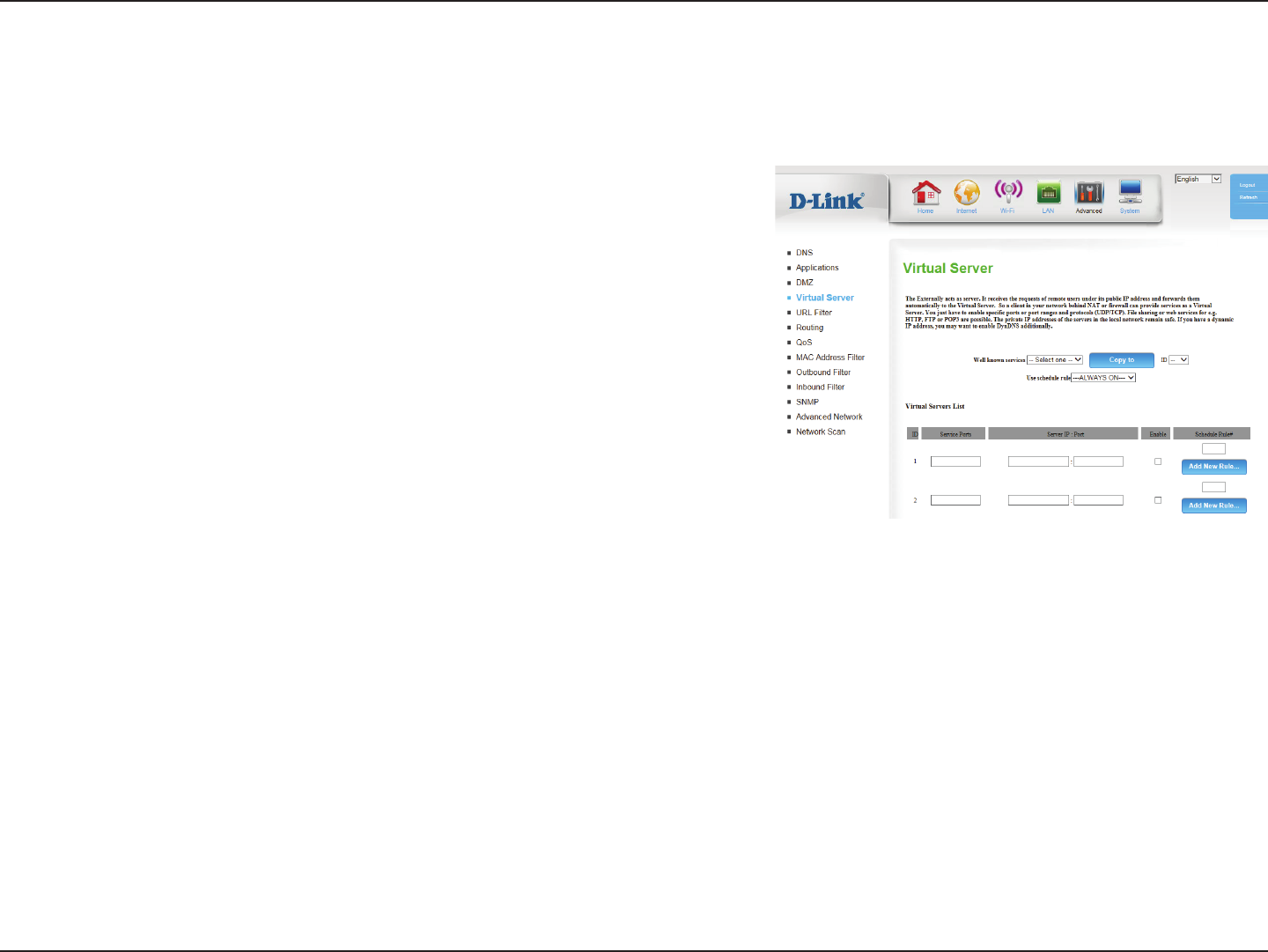
44D-Link DWR-961 User Manual
Section 4 - Conguration
The device can be congured as a virtual server so that users can access services such as Web or FTP via the public (WAN) IP address of the router.
You can also allow the settings to run on a specied schedule.
This contains a list of pre-dened services. You can select a service,
select a rule ID, then click the Copy to button to copy the default
settings for that service to the specied rule ID.
Species which rule to copy the selected Well known service
settings to when you click the Copy to button.
Select a schedule to use and copy to the specied rule ID when
you click the Copy to button. You may select Always On or use
a specic schedule that you have dened. To create and edit
schedules, please refer to Schedules on page 59.
Well-known
Services:
ID:
Use schedule
rule:
VIRTUAL SERVERS LIST
This identies the rule.
Enter the public port(s) you want to open.
Enter the IP address and port of the computer on your local
network that you want to forward the Service Ports to.
Check the box to enable the specied rule.
Specify the schedule rule number. To create schedules, click on
the Add New Rule button. For further information on schedules,
please refer to Schedules on page 59.
Click Apply to save your settings, or Refresh to revert to your
previous settings.
ID:
Service Ports
Server IP: Port:
Enable:
Schedule Rule #:
Virtual Server
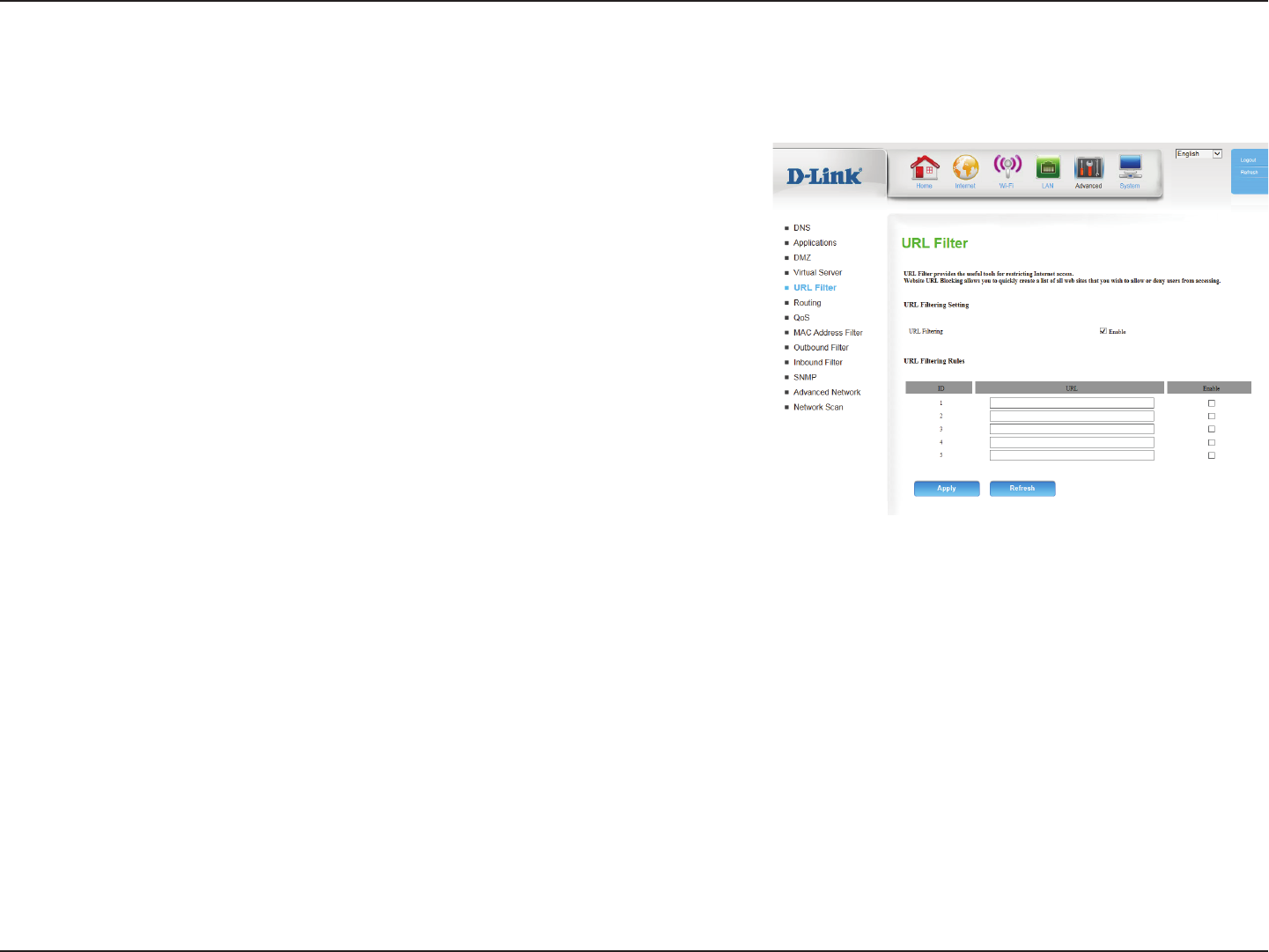
45D-Link DWR-961 User Manual
Section 4 - Conguration
Check the box to enable URL Filtering.
URL FILTERING RULES
This identies the rule.
Enter URL that you would like to block. All URLs that begin with
this address will be blocked.
Check the box to enable the specied rule.
Click Apply to save your settings, or Refresh to revert to your
previous settings.
URL Filter allows you to set up a list of websites that will be blocked from users on your network.
URL Filtering:
ID:
URL:
Enable:
URL Filter
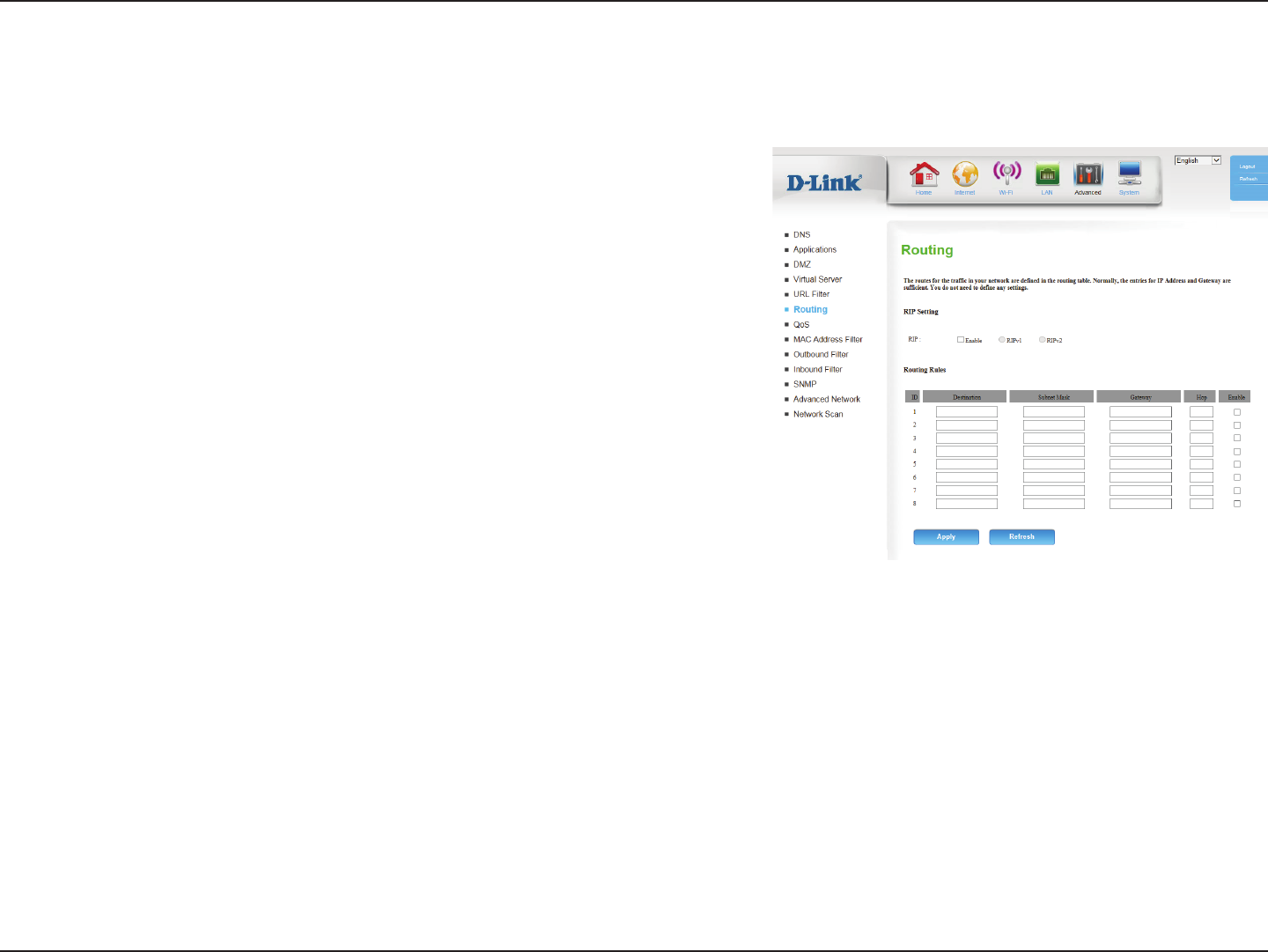
46D-Link DWR-961 User Manual
Section 4 - Conguration
Check the box to enable routing, then select which routing
protocol to use:
• RIPv1: Protocol in which the IP address is routed
through the Internet.
• RIPv2: Enhanced version of RIPv1 with added
features such as authentication, routing domain, next
hop forwarding, and subnet-mask exchange.
RIP:
The Routing page allows you to specify custom routes that determine how data is moved around your network.
ROUTING RULES
This identies the rule.
Enter in the IP of the specied network that you want to access
using the static route.
Enter in the subnet mask to be used for the specied network.
Enter in the gateway IP address for the specied network.
Enter in the amount of hops it will take to reach the specied
network.
Note: In a transmission path, each link is terminated at a network
device such as a router or gateway. The number of hops equals
the number of routers or gateways that data must pass through
before reaching the destination.
Select this box to enable the rule.
Click Apply to save your settings, or Refresh to revert to your
previous settings.
ID:
Destination:
Subnet Mask:
Gateway:
Hop:
Enable:
Routing
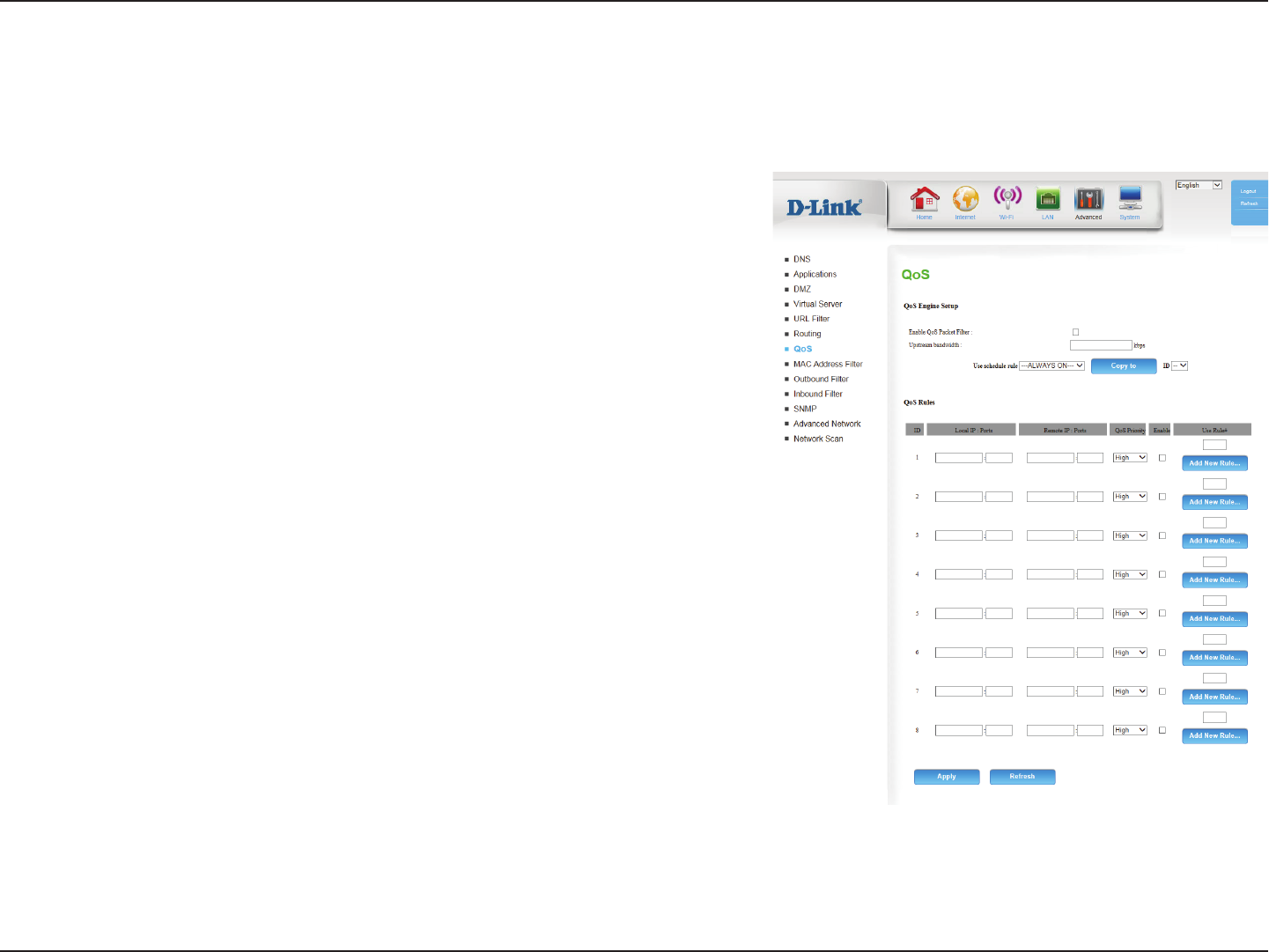
47D-Link DWR-961 User Manual
Section 4 - Conguration
Select this box to enable the QoS feature.
Specify the maximum upstream bandwidth here (e.g. 400 Kbps).
Select a schedule to use and copy to the specied rule ID when
you click the Copy to button. You may select Always On or use
a specic schedule that you have dened. To create and edit
schedules, please refer to Schedules on page 59.
QOS RULES
This identies the rule.
Specify the local IP address(es) and port(s) for the rule to aect.
Specify the remote IP address(es) and port(s) for the rule to aect.
Select what priority level to use for trac aected by the rule:
Low, Normal, or High.
Check the box to enable the specied rule.
Specify the schedule rule number. To create a new schedule,
click on the Add New Rule button. For more information about
schedules, please refer to Schedules on page 59.
Click Apply to save your settings, or Refresh to revert to your
previous settings.
Enable QOS
Packet Filter:
Upstream
Bandwidth:
Use Schedule
Rule:
ID:
Local IP : Ports:
Remote IP : Ports:
QoS Priority:
Enable:
Use Rule #:
The QoS Engine improves your online gaming or streaming media experience by ensuring that your game or media trac is prioritized over other
network trac, such as FTP or web.
QoS
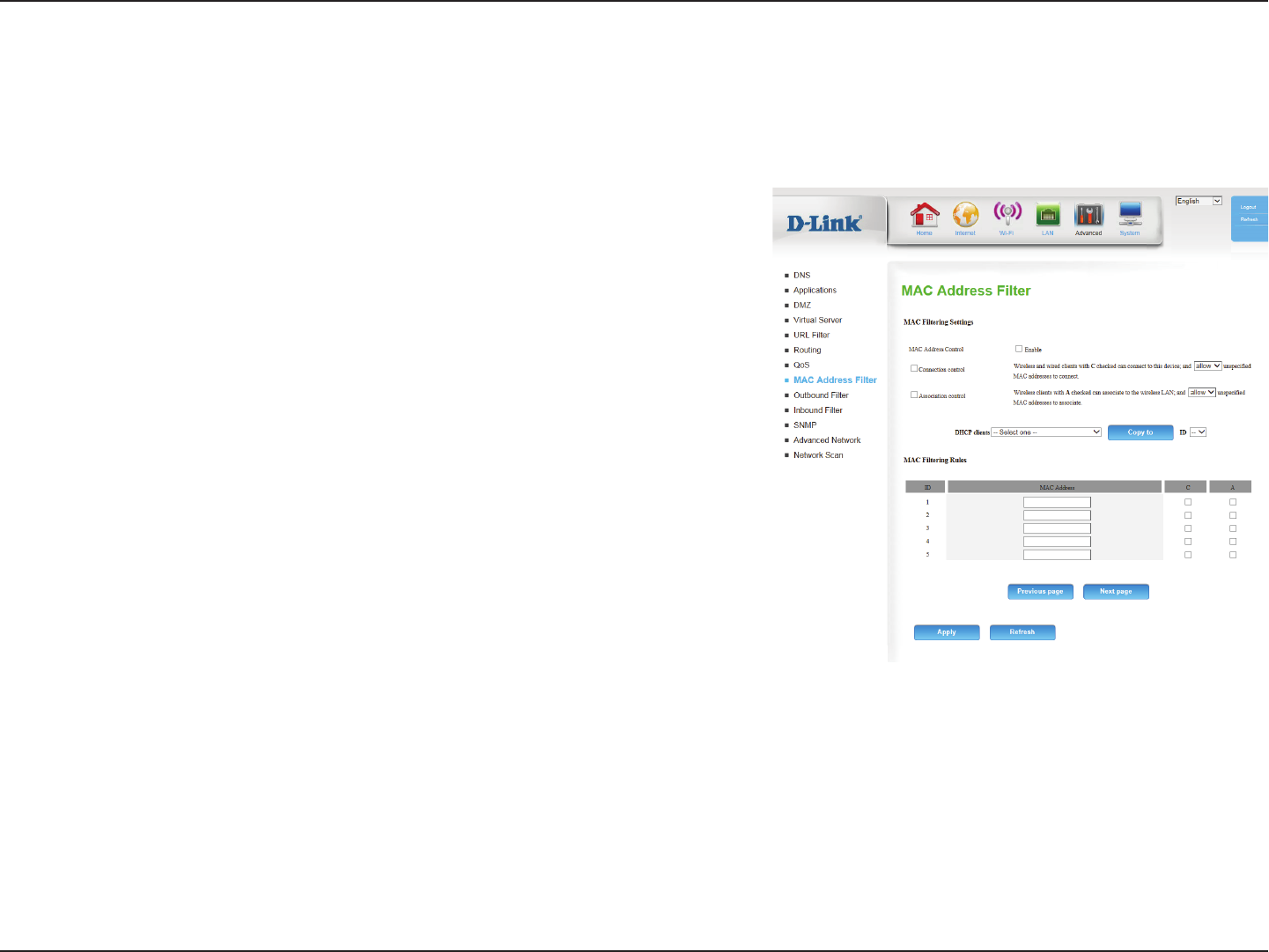
48D-Link DWR-961 User Manual
Section 4 - Conguration
Check this box to enable MAC Filtering.
Check the box to allow wireless and wired clients with C selected
to connect to this device. You can also select to allow or deny
connections from unspecied MAC addresses.
Check the box to allow wireless clients with A selected can
associate to the wireless LAN. You can also select to allow or deny
connections from unspecied MAC addresses.
MAC FILTERING RULES
This identies the rule.
Specify the MAC address of the computer to be ltered.
Specify the last section of the IP address.
If this box is ticked, the rule will follow the connection control
setting specied in MAC ltering settings specied above.
If this box is ticked, the rule will follow the association control
setting specied in MAC ltering settings specied above.
Click Apply to save your settings, or Refresh to revert to your
previous settings.
MAC Address
Control:
Connection
Control:
Association
Control:
ID:
MAC Address:
IP Address:
C:
A:
The MAC (Media Access Controller) Address Filter option is used to control network access based on the MAC address of the network adapter.
A MAC address is a unique ID assigned by the manufacturer of the network adapter. This feature can be congured to ALLOW or DENY network/
Internet access.
MAC Address Filter
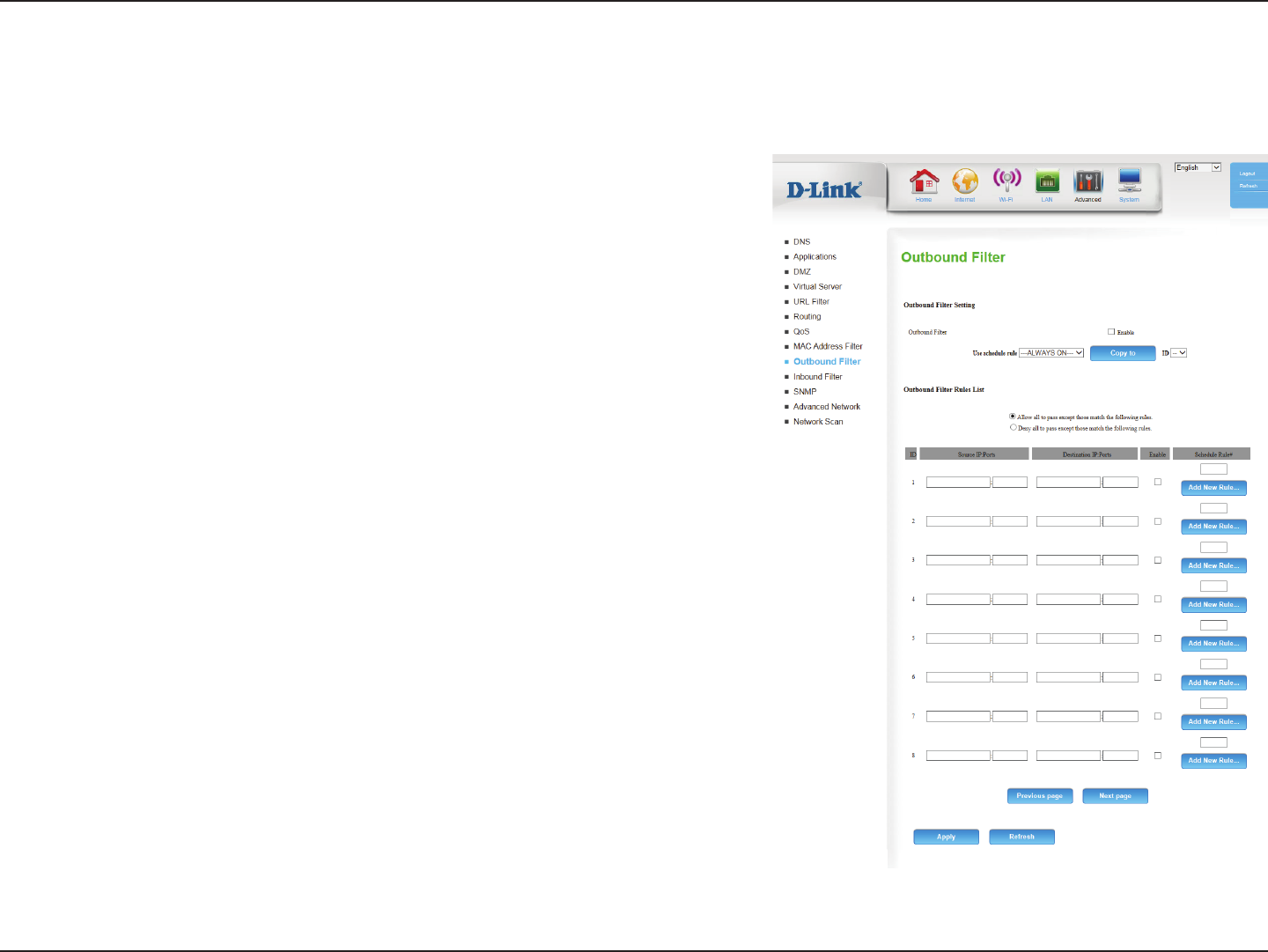
49D-Link DWR-961 User Manual
Section 4 - Conguration
Select this box to Enable outbound ltering.
Select a schedule to use and copy to the specied rule ID when
you click the Copy to button. You may select Always On or use
a specic schedule that you have dened. To create and edit
schedules, please refer to Schedules on page 59.
OUTBOUND FILTER RULES LIST
Here, you can select whether to Allow or Deny all outgoing trac
except for trac that matches the listed rules.
This identies the rule.
Specify the local IP address and then specify the port after the
colon.
Specify the remote IP address and then the port after the colon.
Check the box to enable the specied rule.
Specify the schedule rule number. Click on the Add New Rule
button to create a new schedule rule.
Go back to the previous lter page.
Advance to the next lter page.
Click Apply to save your settings, or Refresh to revert to your
previous settings.
Outbound Filter:
Use Schedule Rule:
ID:
Source IP : Ports:
Destination IP :
Ports:
Enable:
Schedule Rule #:
Previous Page:
Next Page:
Outbound Filter enables you to control what packets are allowed to be sent out to the Internet. The outbound lter applies to all outbound packets.
Outbound Filter
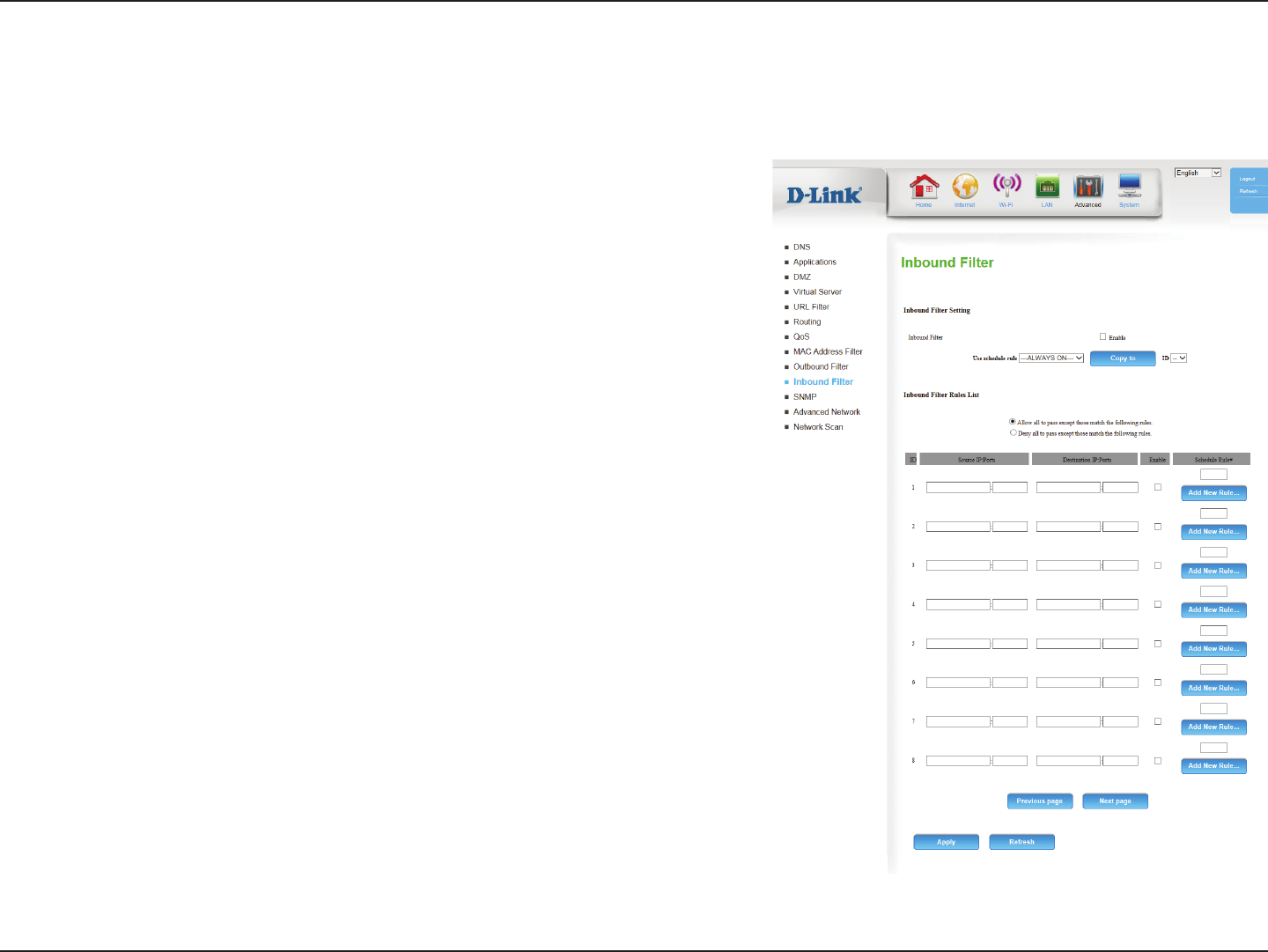
50D-Link DWR-961 User Manual
Section 4 - Conguration
Select this box to Enable the lter.
Select a schedule to use and copy to the specied rule ID when
you click the Copy to button. You may select Always On or use
a specic schedule that you have dened. To create and edit
schedules, please refer to Schedules on page 59.
INBOUND FILTER RULES LIST
Here, you can select whether to Allow or Deny all incoming trac
except for trac that matches the listed rules.
This identies the rule.
Specify the local IP address and then specify the port after the
colon.
Specify the remote IP address and then the port after the colon.
Check the box to enable the specied rule.
Specify the schedule rule number. Click on the Add New Rule
button to create a new schedule rule.
Go back to the previous lter page.
Advance to the next lter page.
Click Apply to save your settings, or Refresh to revert to your
previous settings.
Inbound Filter:
Use Schedule
Rule:
ID:
Source IP : Ports:
Destination IP :
Ports:
Enable:
Schedule Rule #:
Previous Page:
Next Page:
Inbound Filter enables you to control what packets are allowed to come in to your network from the Internet. The inbound lter only applies to
packets that are destined for Virtual Servers or DMZ hosts.
Inbound Filter
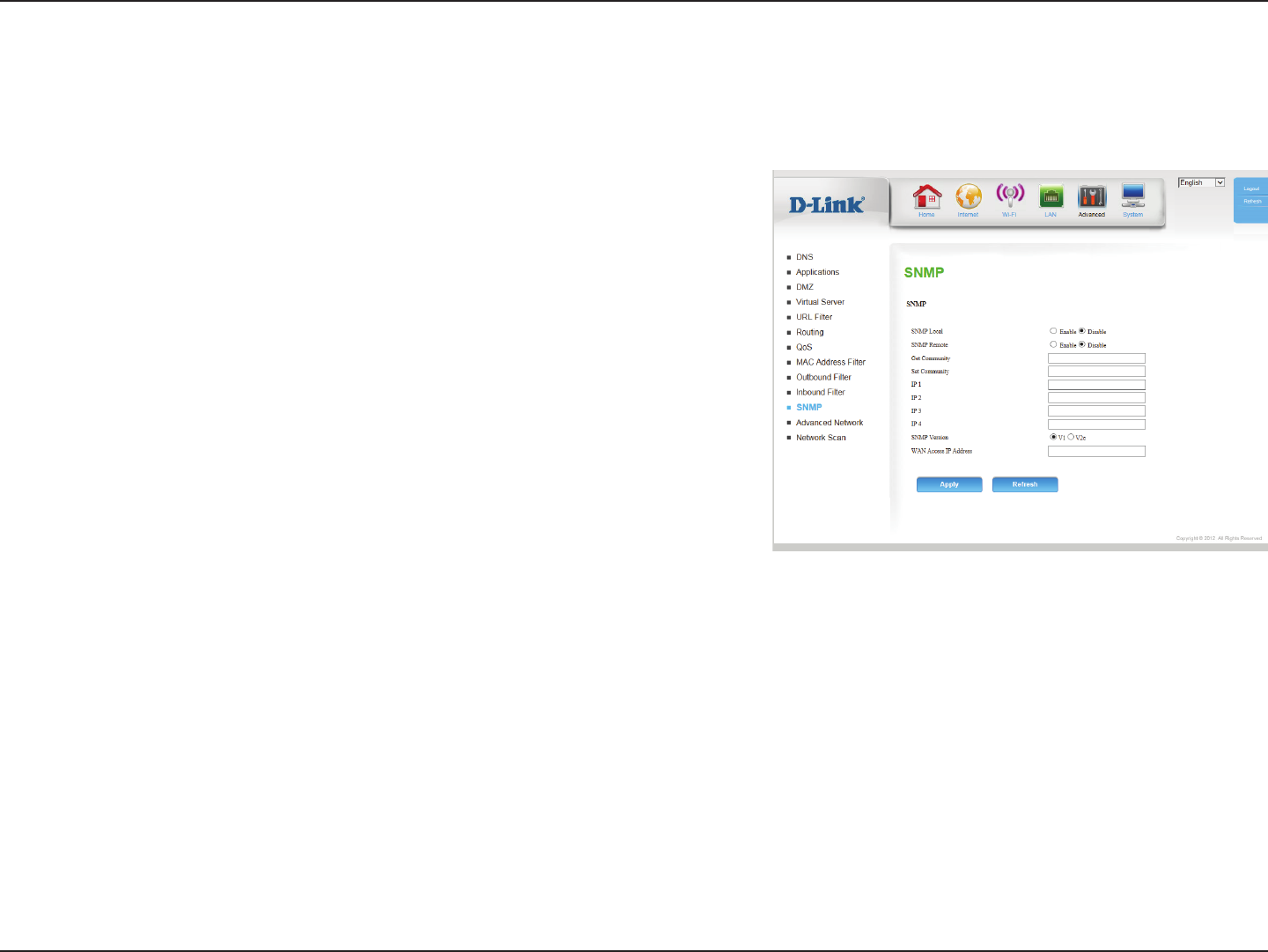
51D-Link DWR-961 User Manual
Section 4 - Conguration
Select whether to Enable or Disable local SNMP administration.
Select whether to Enable or Disable remote SNMP administration.
Enter the password public in this eld to allow read-only access
to network administration using SNMP. You can view the network,
but no conguration is possible with this setting.
Enter the password private in this eld to enable read/write
access to the network using SNMP.
Enter up to 4 IP addresses to use as trap targets for your network.
Select the SNMP version of your system.
If you want to limit remote access SNMP access, enter the IP
address of the remote computer you will use to access this device;
all other IP addresses will be denied remote SNMP access.
Click Apply to save your settings, or Refresh to revert to your
previous settings.
SNMP Local:
SNMP Remote:
Get Community:
Set Community:
IP 1/IP 2/IP 3/IP 4:
SNMP Version:
WAN Access
IP Address
SNMP (Simple Network Management Protocol) is a widely used network monitoring and control protocol that reports activity on each network device
to the administrator of the network. SNMP can be used to monitor trac and statistics of the DWR-961. The DWR-961 supports SNMP v1 and v2c.
SNMP
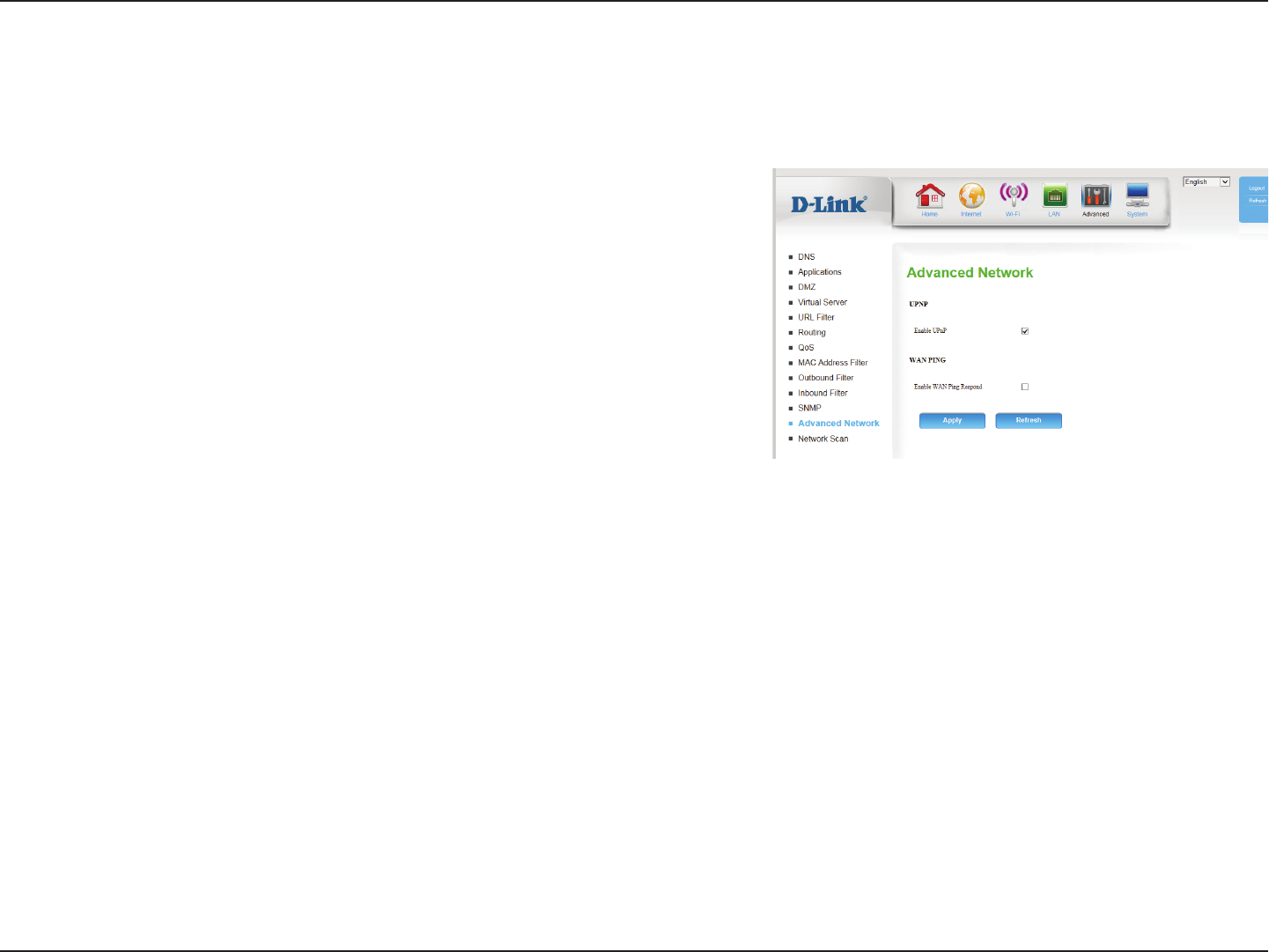
52D-Link DWR-961 User Manual
Section 4 - Conguration
Check the box to enable the Universal Plug and Play (UPnP™)
feature. UPNP provides compatibility with various networking
equipment, software, and peripherals.
Select the box to allow the WAN port to be “pinged.” Blocking WAN
pings may provide some extra security from hackers.
Click Apply to save your settings, or Refresh to revert to your
previous settings.
Advanced Network contains settings which can change the way the router handles certain types of trac. We recommend that you do not change
any of these settings unless you are already familiar with them or have been instructed to make the change by one of our support personnel.
Enable UPnP:
Enable WAN Ping
Respond:
Advanced Network
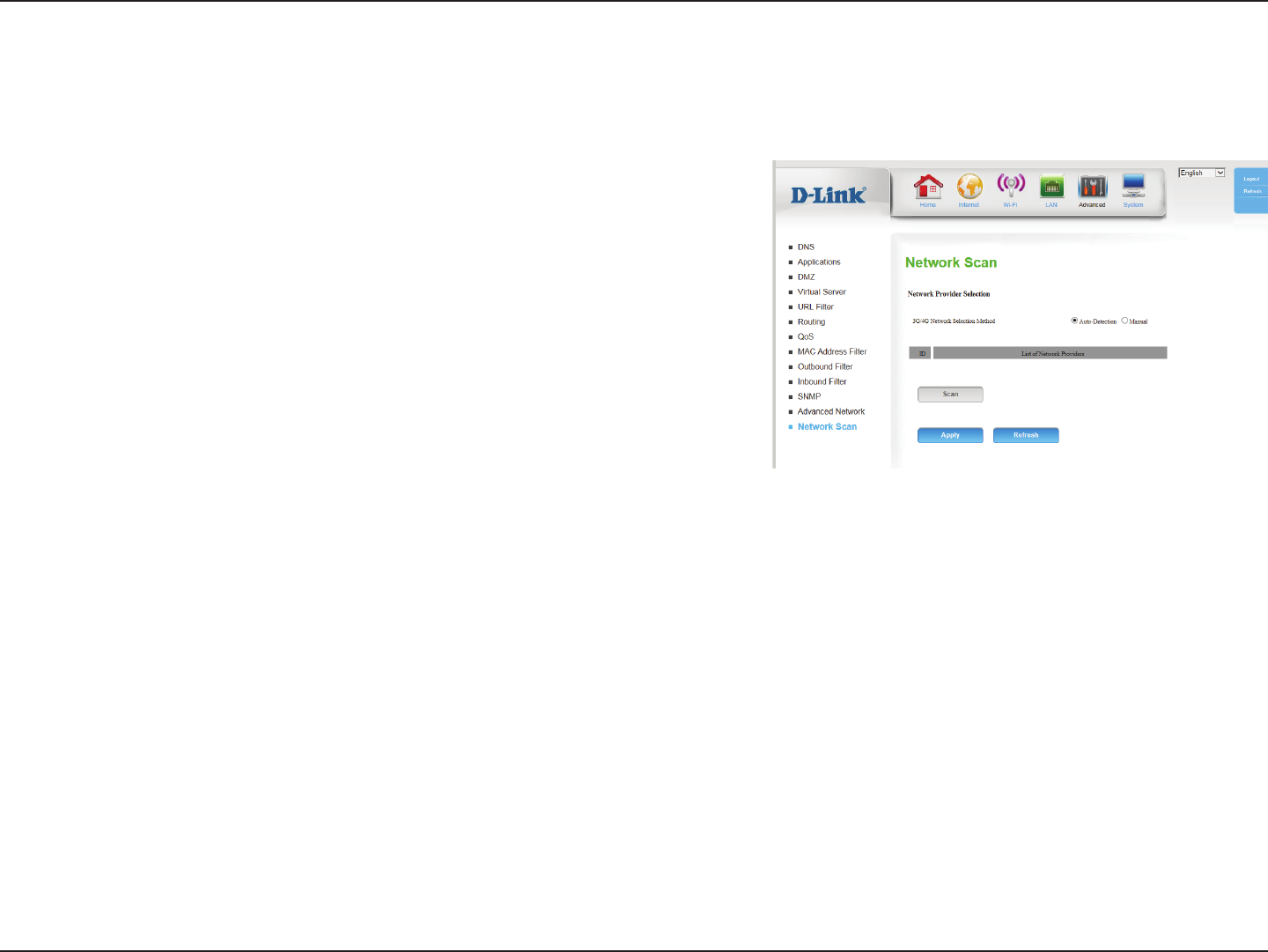
53D-Link DWR-961 User Manual
Section 4 - Conguration
Leave this setting on Auto to allow the DWR-961 to automatically
select a cellular network to connect to. If you need to select a
network manually, select Manual, click the Scan button, then
select an available network to connect to.
Note: You will only be able to scan for networks if the DWR-961 is
not currently connected to a 4G network.
Click Apply to save your settings, or Refresh to revert to your
previous settings.
This page lets you set whether to allow the DWR-961 to automatically select a 4G network based on the inserted SIM/UICC card, and allows you
to manually scan for networks and select one to connect to.
4G Network
Selection
Method:
Network Scan
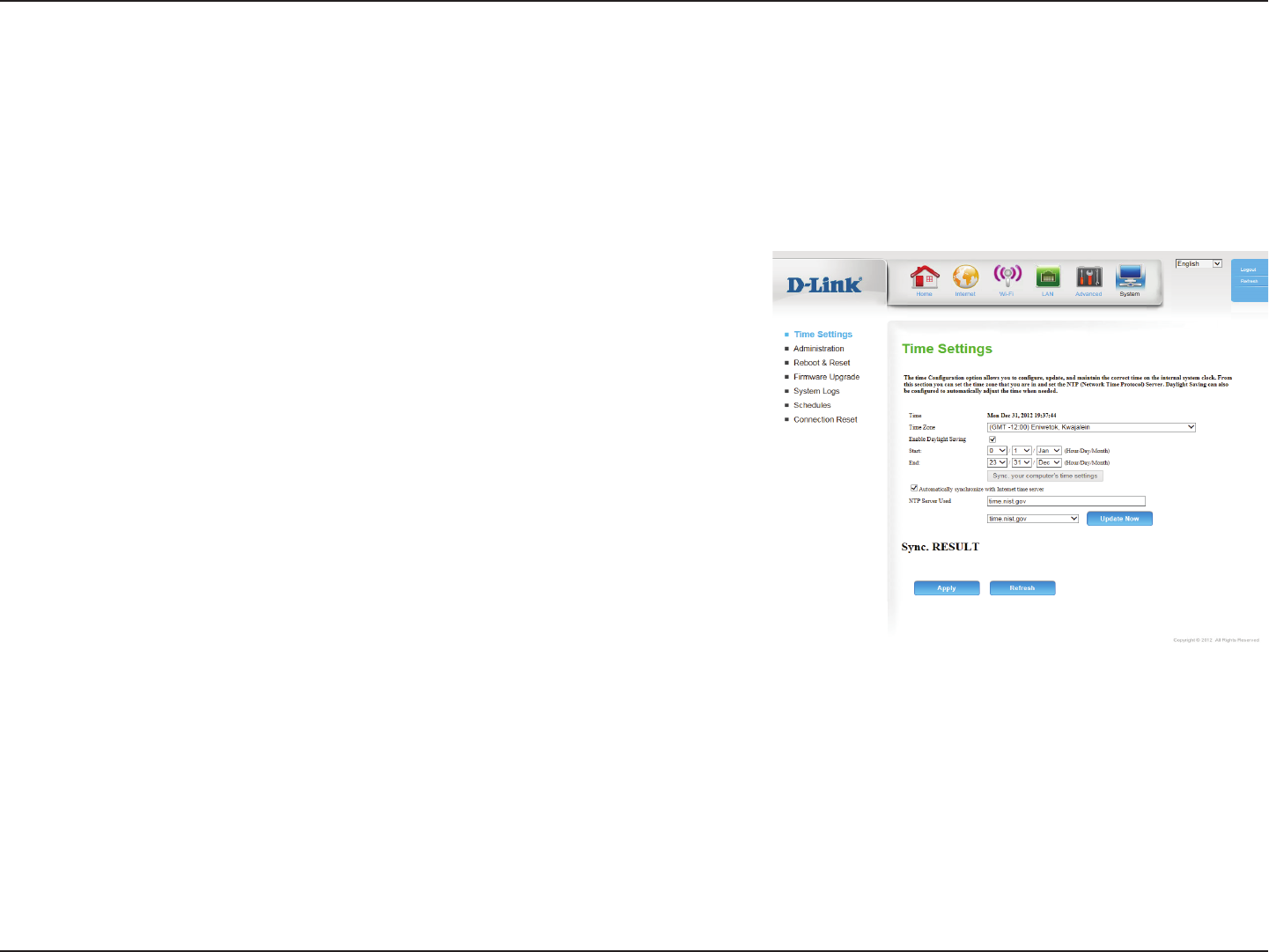
54D-Link DWR-961 User Manual
Section 4 - Conguration
Select the appropriate Time Zone from the drop-down box.
Check the box to allow for daylight saving adjustments. Use the
drop-down boxes to specify a start date and end date for daylight
saving time adjustments.
This button allows the router to set time zone and current time
based on your computer’s conguration. To use this setting,
ensure that Automatic Synchronization is unchecked and applied.
Check the box to allow the router to use an NTP server to update
the router’s internal clock.
Enter an NTP server to use for time synchronization, or use the
drop-down box to select one. Click the Update Now button to
synchronize the time with the NTP server.
Click Apply to save your settings, or Refresh to revert to your
previous settings.
This section will help you set the time zone that you are in and an NTP (Network Time Protocol) server to use. Daylight Saving can also be congured
to adjust the time when needed.
Time Zone:
Enable Daylight
Saving:
Sync your
computer’s time
settings:
Automatically
synchronize with
Internet time
server:
NTP Server Used:
System
Time Settings
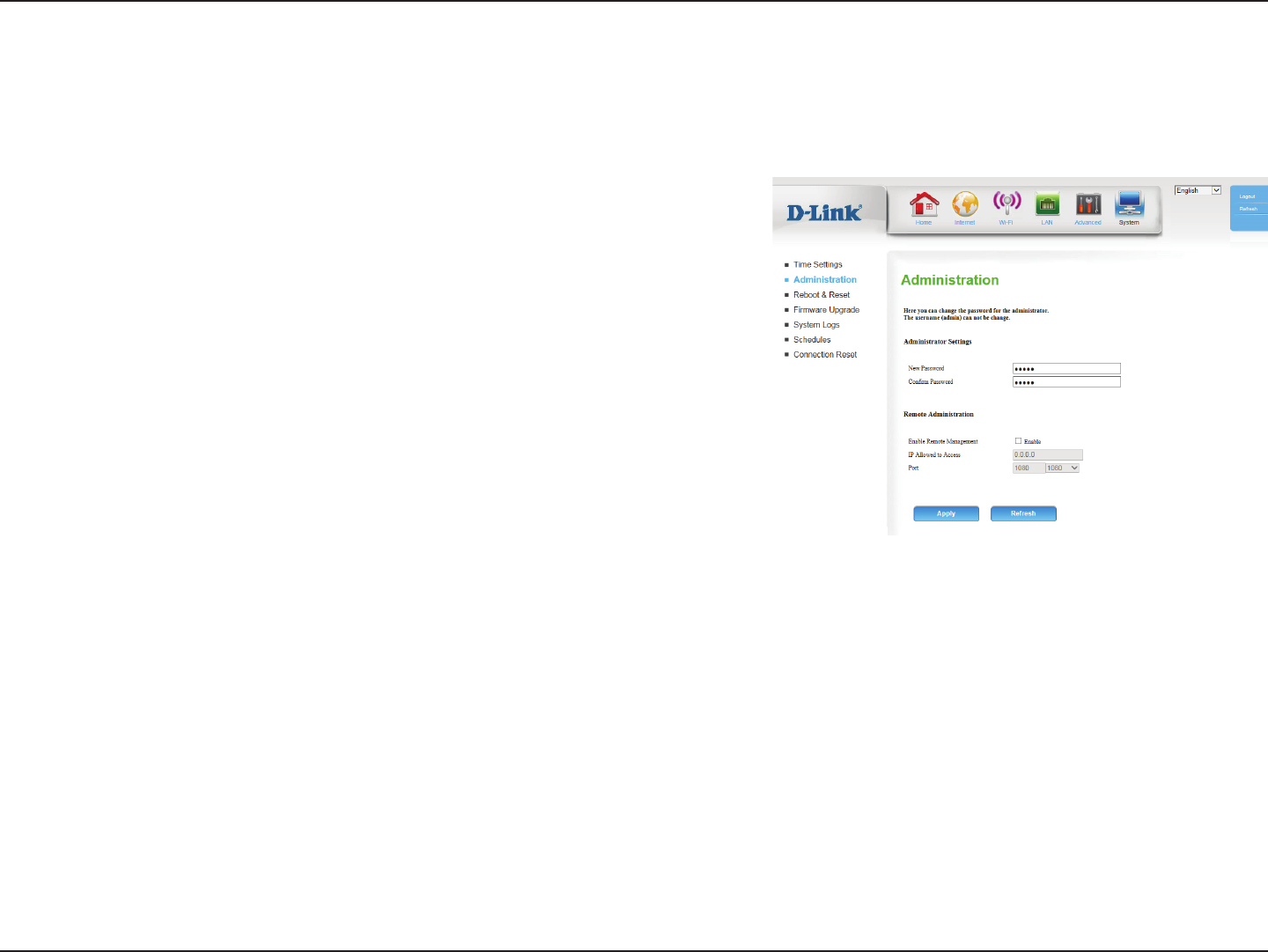
55D-Link DWR-961 User Manual
Section 4 - Conguration
Enter and conrm the password that the admin account will use to
access the router’s management interface.
Tick this check box to enable remote management. Remote
management allows the DWR-961 to be congured over the
Internet through a web browser. A username and password will
still be required to access the web-management interface.
Enter the Internet IP address of the PC that has access to the
broadband router. If you enter an asterisk (*) in this eld, then
anyone will be able to access the router. Adding an asterisk (*) into
this eld could present a security risk and is not recommended.
This is the port number used to access the router. 8080 is the port
usually used for the web-management interface.
Click Apply to save your settings, or Refresh to revert to your
previous settings.
The Admin page allows you to change the Administrator password and enable Remote Management. The admin has read/write access while users
only have read-only access. Only the admin has the ability to change both admin and user account passwords.
Admin Password:
Remote
Management:
IP Allowed to
Access:
Port:
Administration
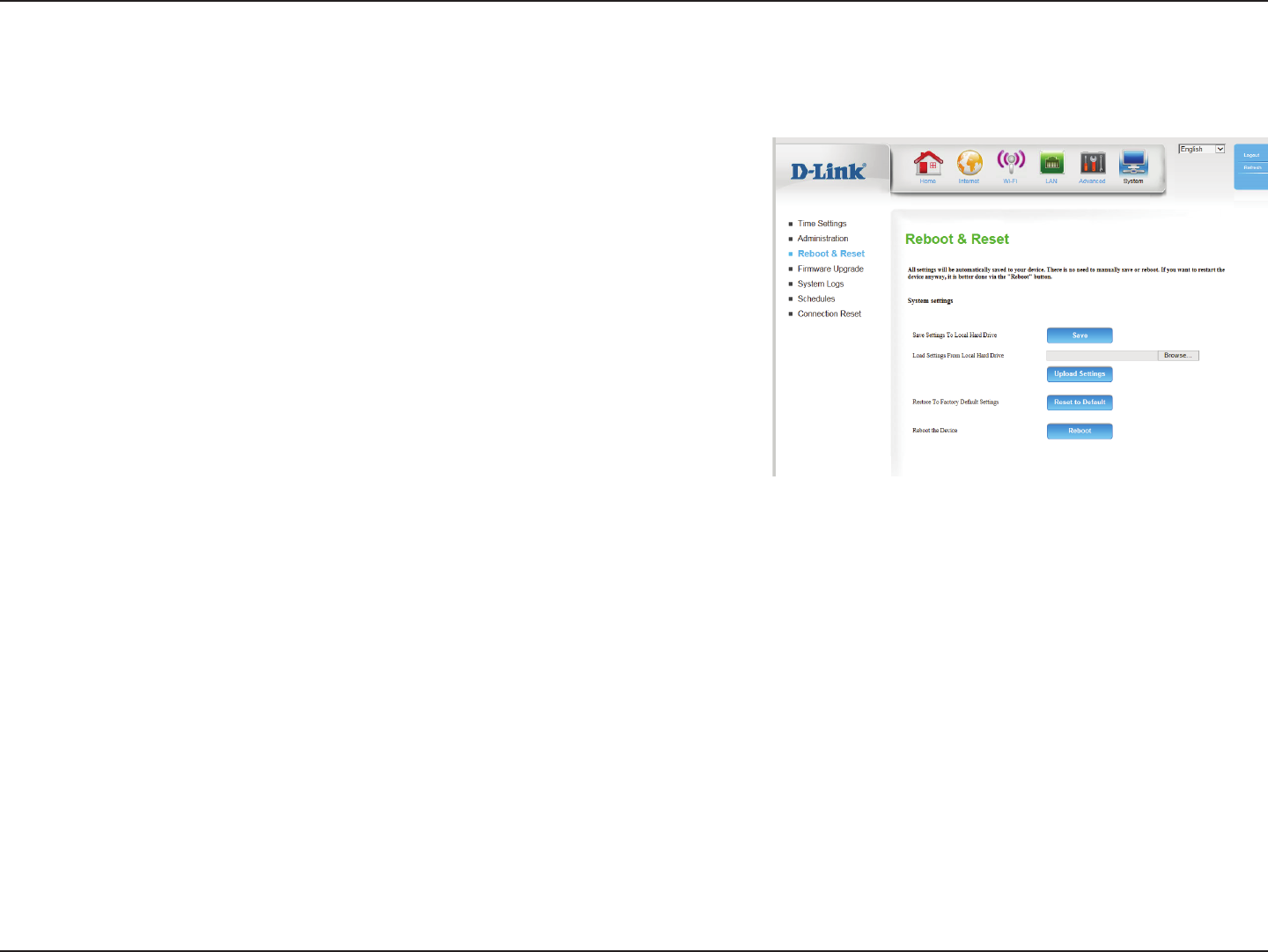
56D-Link DWR-961 User Manual
Section 4 - Conguration
Use this option to save your current router conguration settings
to a le. Click Save to open a le dialog, and then select a location
and le name for the settings.
Use this option to load previously saved router conguration
settings. Click Choose File and select the saved le and then click
the Upload Settings button to upload the settings to the router.
This option will restore all settings back to their defaults. Any
settings that have not been backed up will be lost, including any
rules that you have created.
This option will reboot the router.
Save Settings To
Local Hard Drive
Load Settings
From Local Hard
Drive:
Restore To Factory
Default Settings:
Reboot the
Device:
Here, you can save the current system settings to a local hard drive.
Reboot & Reset
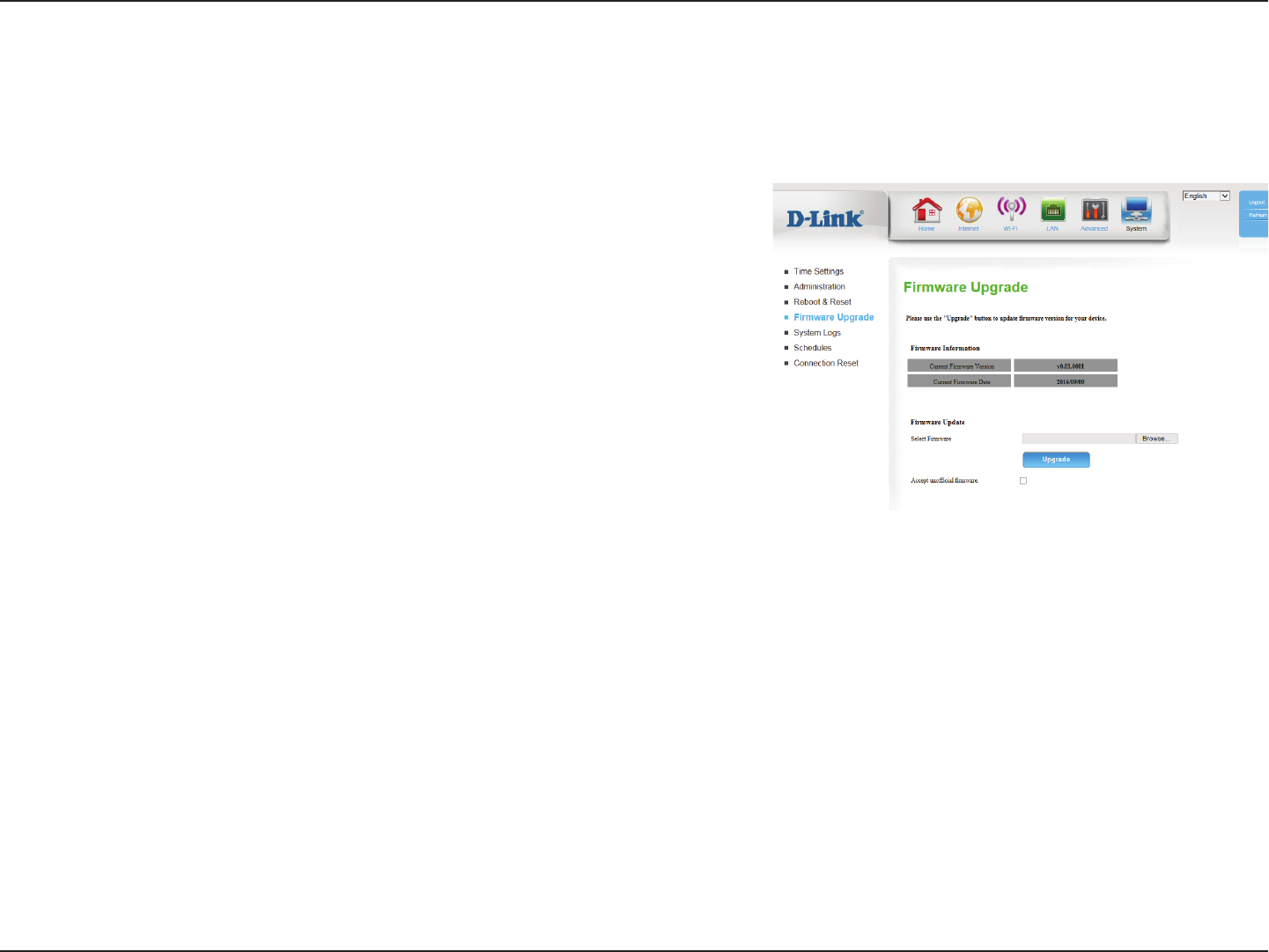
57D-Link DWR-961 User Manual
Section 4 - Conguration
Displays your current rmware’s version.
Displays your current rmware’s release date.
After you have downloaded a new rmware, click Browse to
locate the rmware on your computer, then click Upload to start
the rmware upgrade.
Warning: You must use a wired connection to upload the rmware
le; do not use a wireless connection. During the upgrade
process, do not power o your computer or router, and
do not refresh the browser window until the upgrade is
complete.
If the rmware you want to install is not an ocial D-Link release,
you will need to check this box.
Warning: Unocial rmware is not supported, and may cause
damage to your device. Use of unocial rmware is at
your own risk.
Here, you can upgrade the rmware of your router. Make sure the rmware you want to use is on the local hard drive of the
computer and then click Browse to upload the le. You can check for and download rmware updates at the D-Link support site at
http://support.dlink.com.
Current Firmware
Version:
Current Firmware
Date:
Select Firmware:
Accept Unocial
Firmware:
Firmware Upgrade
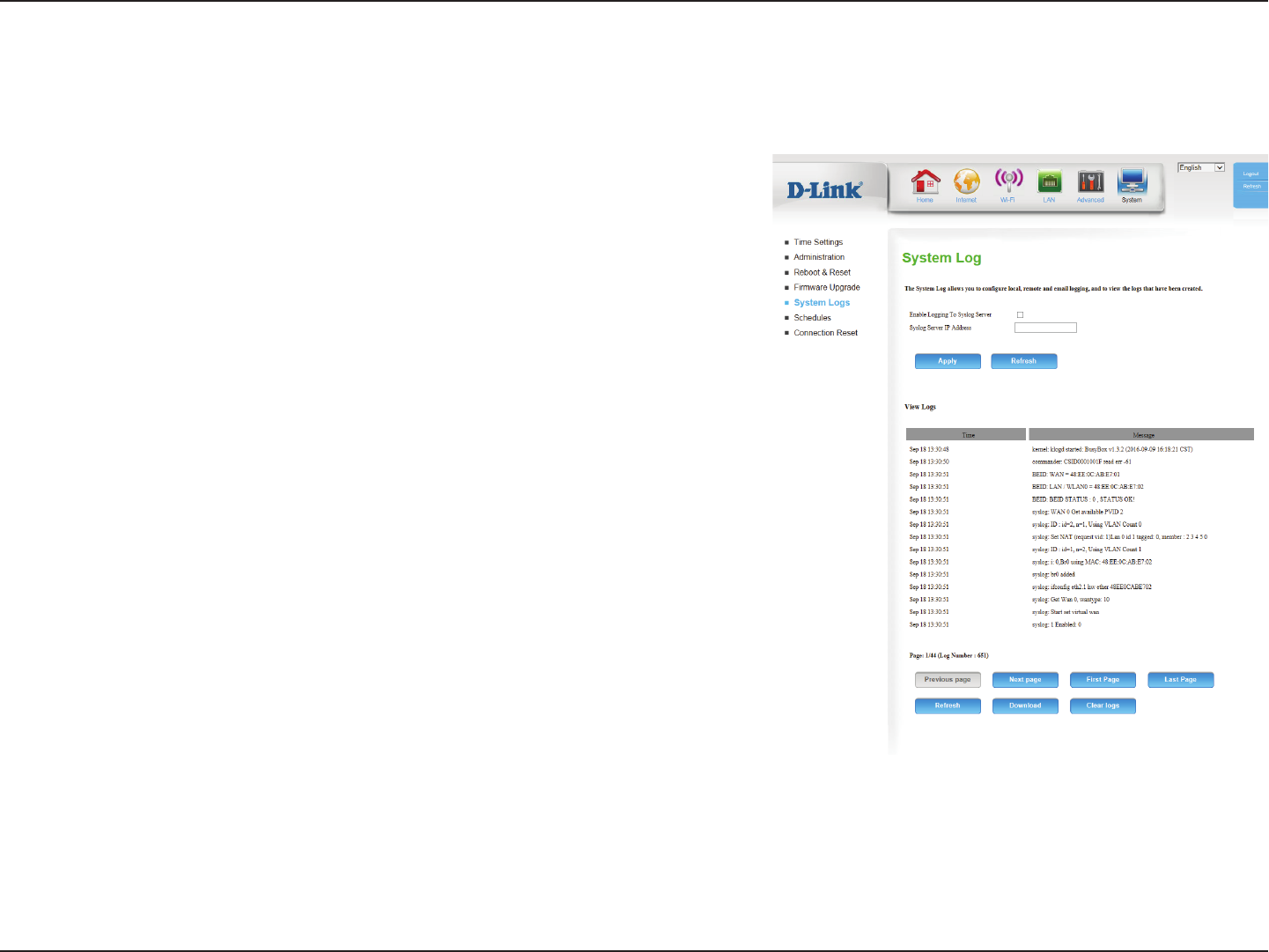
58D-Link DWR-961 User Manual
Section 4 - Conguration
Check the box to send the router logs to a Syslog server.
Enter the IP address of the Syslog server that the router will send
the logs to.
Click Apply to save your settings, or Refresh to revert to your
previous settings.
The DWR-961 keeps a running log of events and activities occurring on the router. You may send these logs to a Syslog server on your network.
Enable Logging to
Syslog Server:
Syslog Server IP
Address:
System Logs
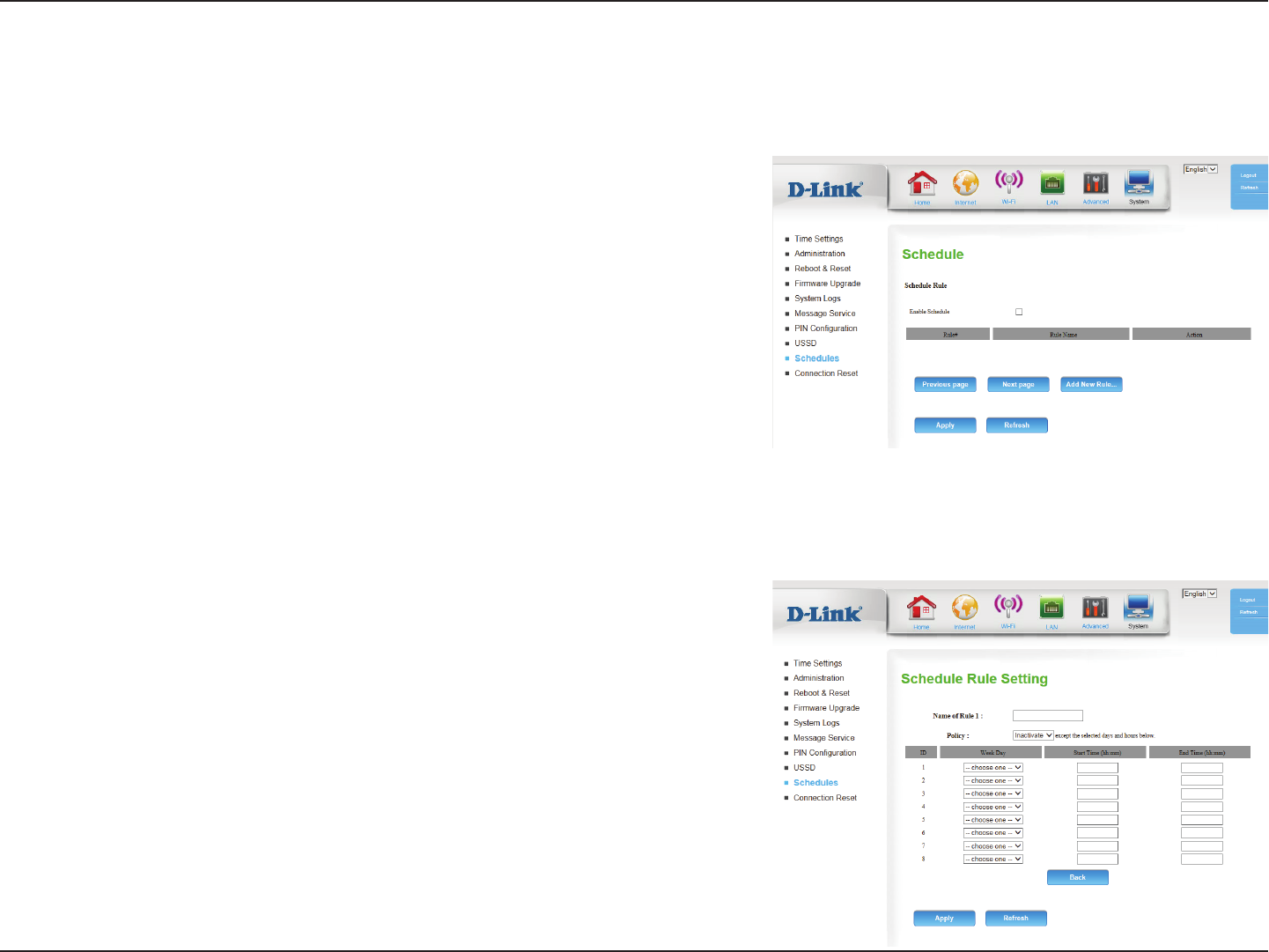
59D-Link DWR-961 User Manual
Section 4 - Conguration
Check this box to enable schedules.
Click this icon to edit the selected rule. (see below)
Click this icon to delete the selected rule.
Click this button to go to the previous page of rules.
Click this button to go to the next page of rules.
Click this button to specify the start time, end time, and name of
the rule.
Click this button to create a new rule. (see below)
This section allows you to manage schedule rules for various rewall and parental control features. Click Apply to save your settings, or Refresh to
revert to your previous settings.
Enable Schedule:
Edit:
Delete:
Previous Page:
Next Page:
Add New Rule..:
Enter a name for your new schedule.
Select Activate or Inactivate to decide whether features that use
the schedule should be active or inactive except during the times
specied.
Select a day of the week for the start time and end time.
Enter the time at which you would like the schedule to become
active.
Select the time at which you would like the schedule to become
inactive.
Name of Rule #:
Policy:
Week Day:
Start Time
(hh:mm):
End Time
(hh:mm):
Schedules
Add New Rule

60D-Link DWR-961 User Manual
Section 4 - Conguration
Select whether the connection reset feature should be enabled or
disabled.
If the connection reset feature is enabled, select when it should
activate via the hour and minute from the dropdown boxes.
Select this option if you want the connection reset feature to
activate on a daily schedule.
Select this option if you want the connection reset feature to
activate only on a certain day of the week.
Select this option if you want the connection reset feature to
activate only on a certain day of the month.
This feature allows you to reset the Internet connection on your router by periodically resetting the connection. You can choose to have this happen
on a predetermined schedule by conguring the options on this page.
Auto-Reboot:
Reboot-Schedule:
Daily Schedule:
Weekly Schedule
Day of Week:
Date of Month:
Connection Reset
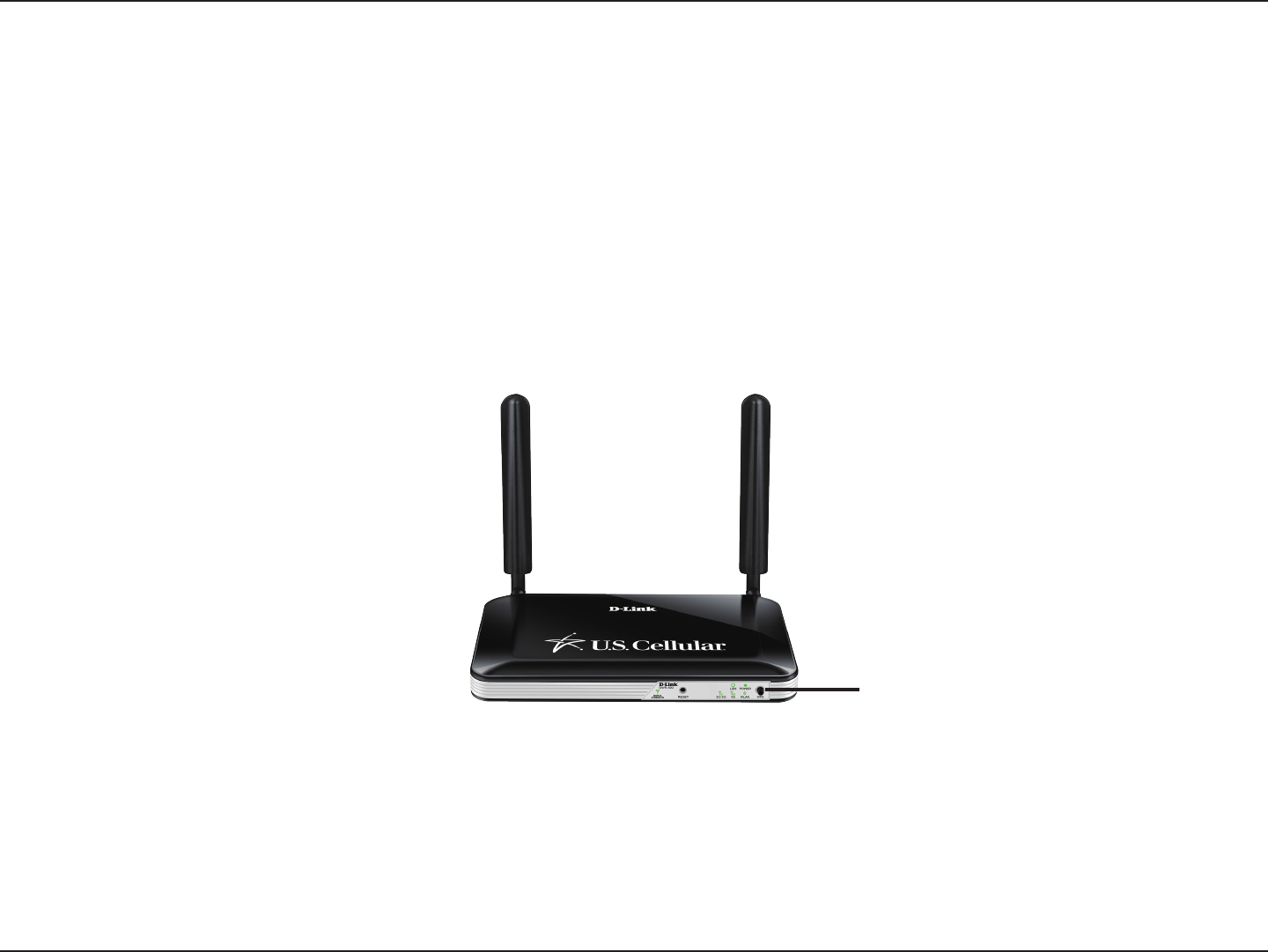
61D-Link DWR-961 User Manual
Section 5 - Connecting to a Wireless Network
Connect a Wireless Client to your Router
WPS Button
Step 2 - Within 2 minutes, press the WPS button on your wireless client (or launch the software utility and start the WPS
process).
The easiest and most secure way to connect your wireless devices to the router is with WPS (Wi-Fi Protected Setup). Most wireless
devices such as wireless adapters, media players, Blu-ray DVD players, wireless printers and cameras will have a WPS button
(or a software utility with WPS) that you can press to connect to the DWR-961 router. Please refer to your user manual for the
wireless device you want to connect to make sure you understand how to enable WPS. Once you know, follow the steps below:
Step 1 - Press the WPS button on the DWR-961 for about 6 seconds. The WLAN LED on the front will start to blink.
Step 3 - Allow up to 1 minute for your connection to be congured. Once the Internet light stops blinking, you will be connected
and your wireless connection will be secure with WPA2.
WPS Button
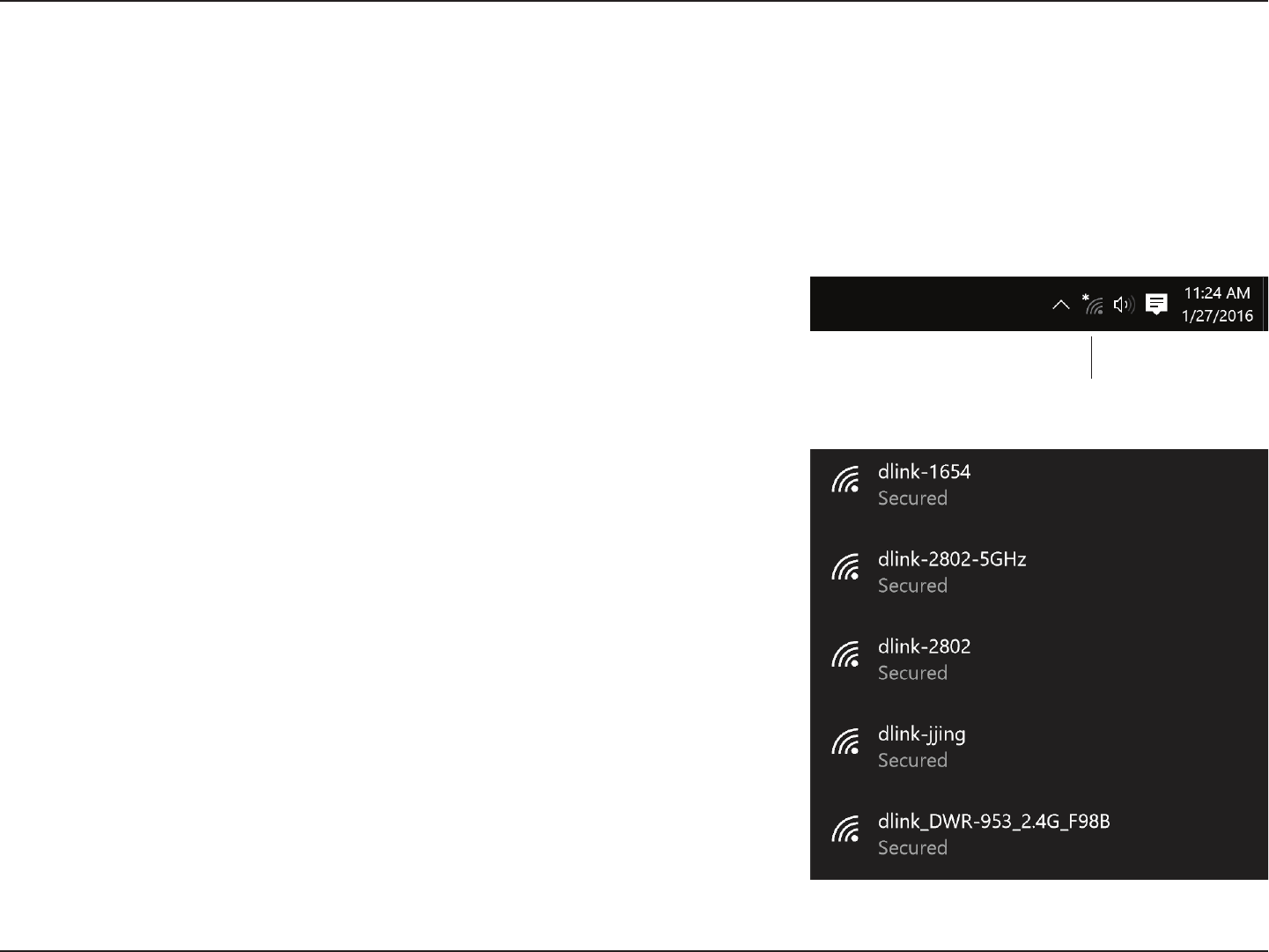
62D-Link DWR-961 User Manual
Section 4 - Connecting a Wireless Client
To connect to a wireless network using Windows 10, you will need to know the wireless network name (SSID) and Wi-Fi password
(security key) of the device you are connecting to.
To join an existing network, locate the wireless network icon in the taskbar,
next to the time display and click on it.
Wireless Icon
Clicking on this icon will display a list of wireless networks which are within
range of your computer. Select the desired network by clicking on its SSID.
Connecting to a Wireless Network
Windows® 10
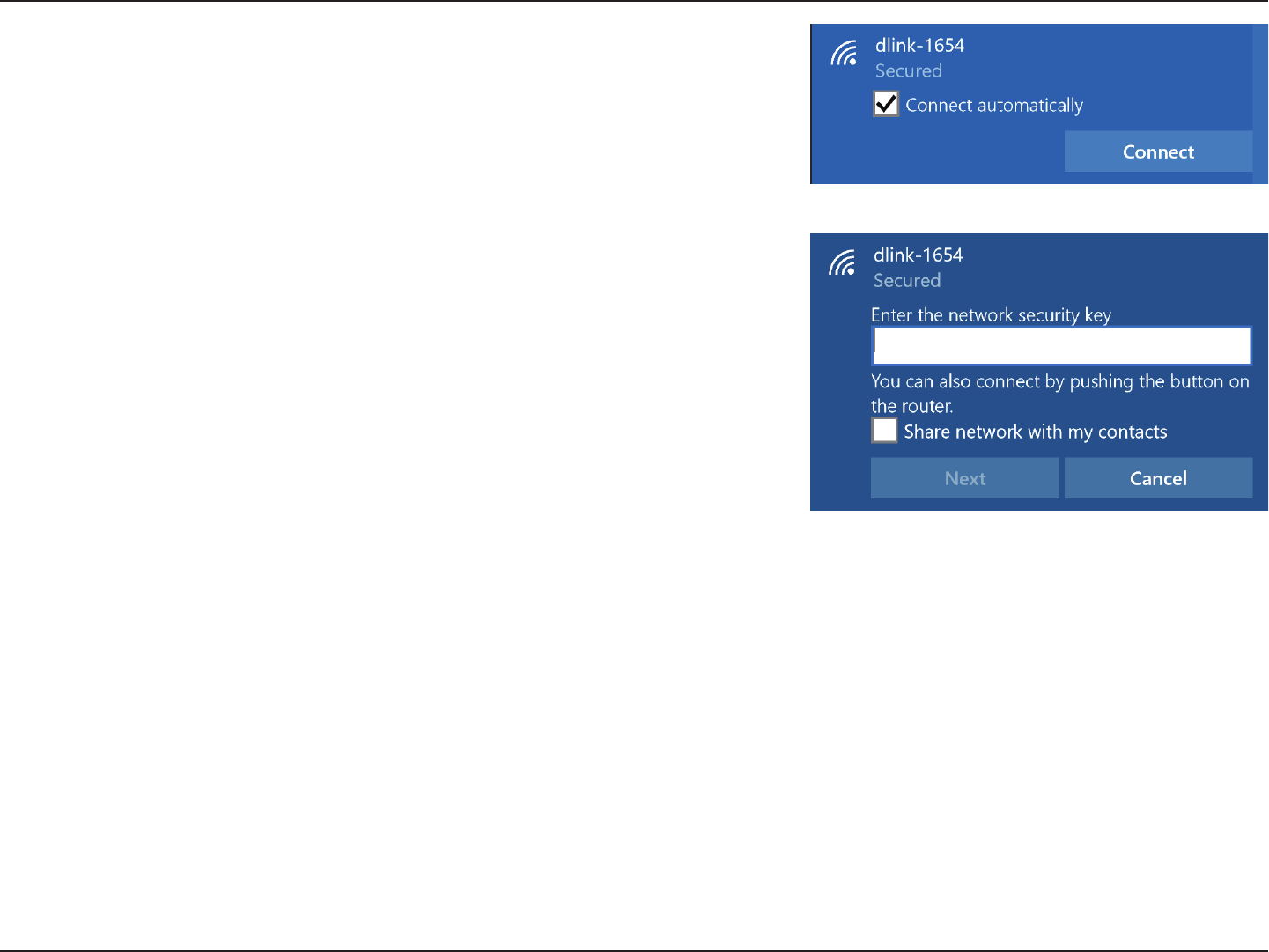
63D-Link DWR-961User Manual
Section 4 - Connecting a Wireless Client
To connect to the network, click Connect.
To automatically connect when your device is in range, click the Connect
Automatically check box. Your computer will now automatically connect to
this wireless network whenever it is detected.
You will then be prompted to enter the Wi-Fi password (network security key)
for the wireless network. Enter the password into the box and click Next to
connect to the network.
You can also use Wi-Fi Protected Setup (WPS) to connect to the wireless network.
Press the WPS button on your device and you will be automatically connected.
It may take 20-30 seconds to connect to the wireless network. If the connection
fails, please verify that the security settings are correct. The key or passphrase
must be exactly the same as the one on the wireless router.
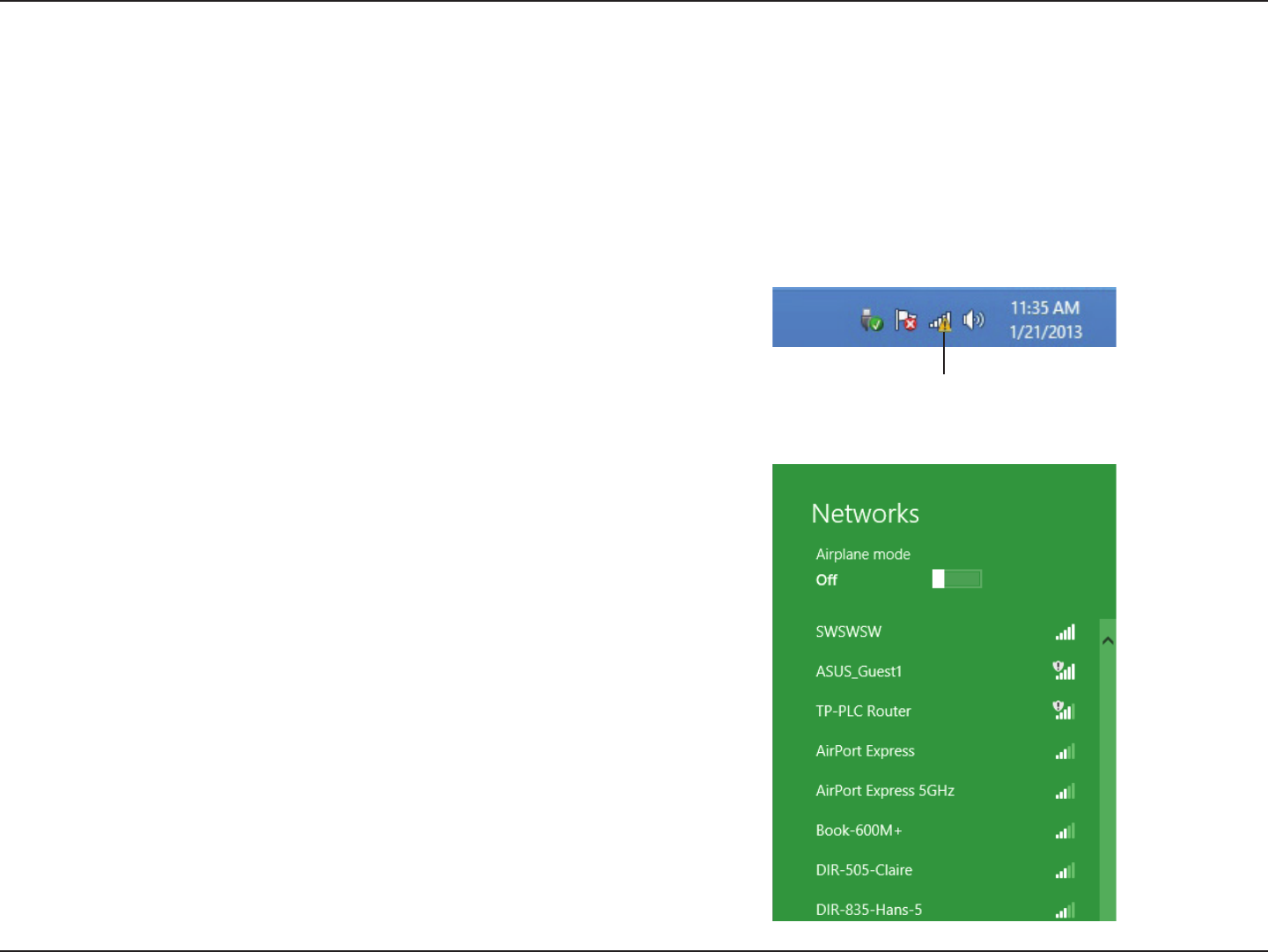
64D-Link DWR-961 User Manual
Section 5 - Connecting to a Wireless Network
Windows® 8
WPA/WPA2
It is recommended that you enable wireless security (WPA/WPA2) on your wireless router or access point before conguring
your wireless adapter. If you are joining an existing network, you will need to know the security key (Wi-Fi password) being used.
To join an existing network, locate the wireless network icon in the
taskbar next to the time display.
Wireless Icon
Clicking on this icon will display a list of wireless networks that are within
connecting proximity of your computer. Select the desired network by
clicking on the network name.
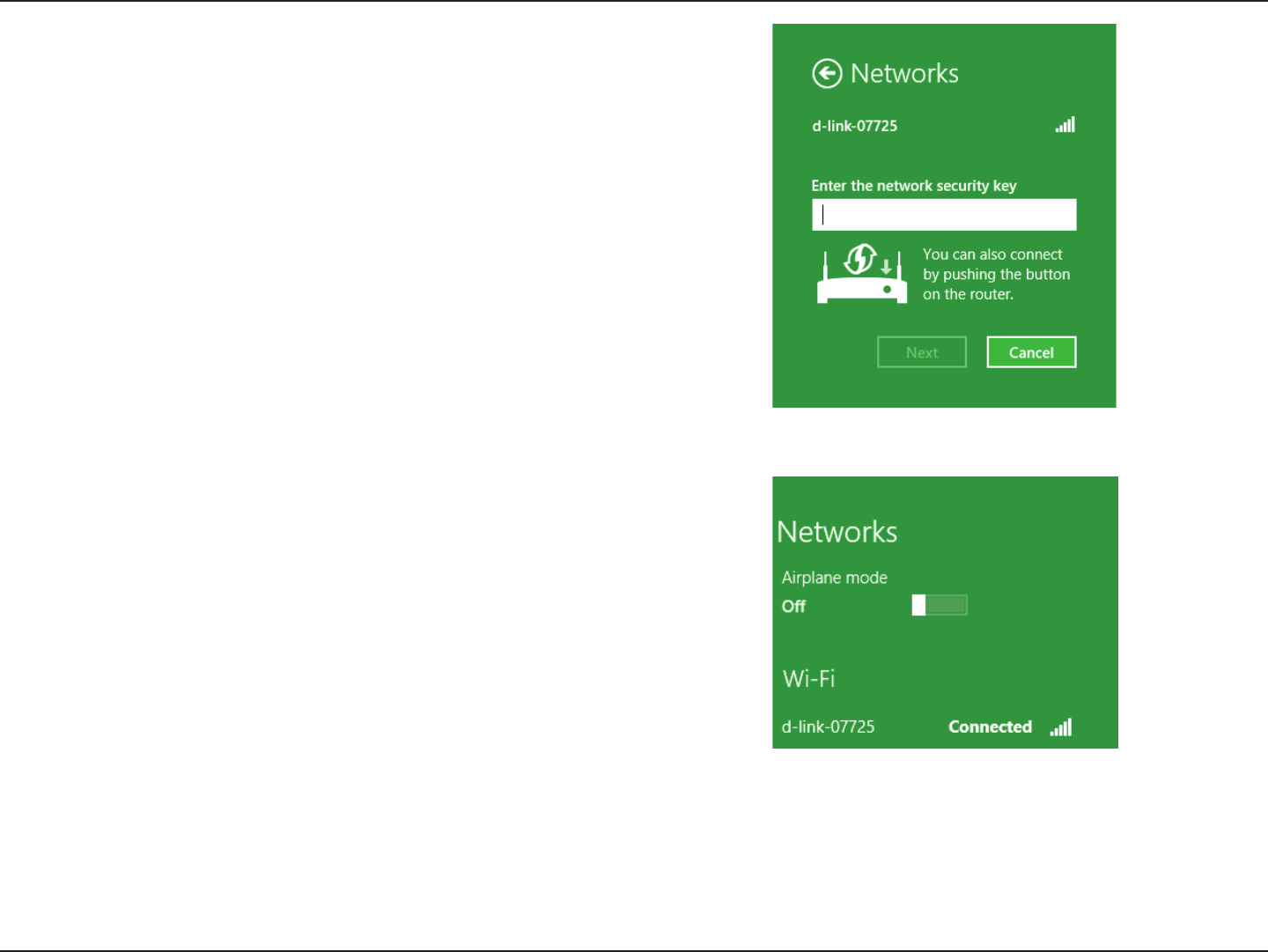
65D-Link DWR-961 User Manual
Section 5 - Connecting to a Wireless Network
You will then be prompted to enter the network security key (Wi-Fi
password) for the wireless network. Enter the password into the box
and click Next.
If you wish to use Wi-Fi Protected Setup (WPS) to connect to the router,
you can also press the WPS button on your router during this step to
enable the WPS function.
When you have established a successful connection to a wireless network,
the word Connected will appear next to the name of the network to
which you are connected to.
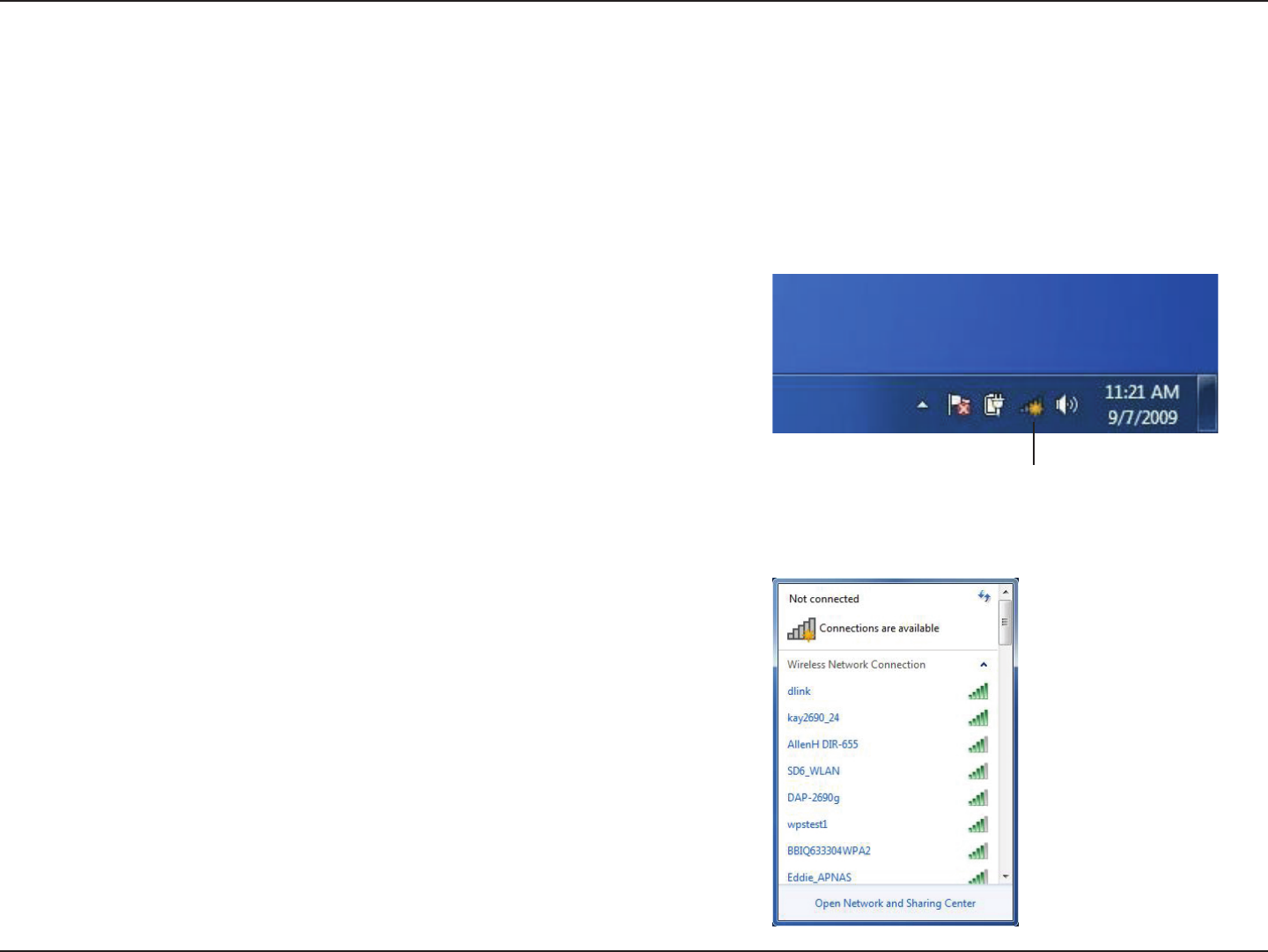
66D-Link DWR-961 User Manual
Section 5 - Connecting to a Wireless Network
Windows® 7
It is recommended that you enable wireless security (WPA/WPA2) on your wireless router or access point before conguring
your wireless adapter. If you are joining an existing network, you will need to know the security key or passphrase being used.
1. Click on the wireless icon in your system tray (lower-right corner).
2. The utility will display any available wireless networks in your area.
Wireless Icon
WPA/WPA2
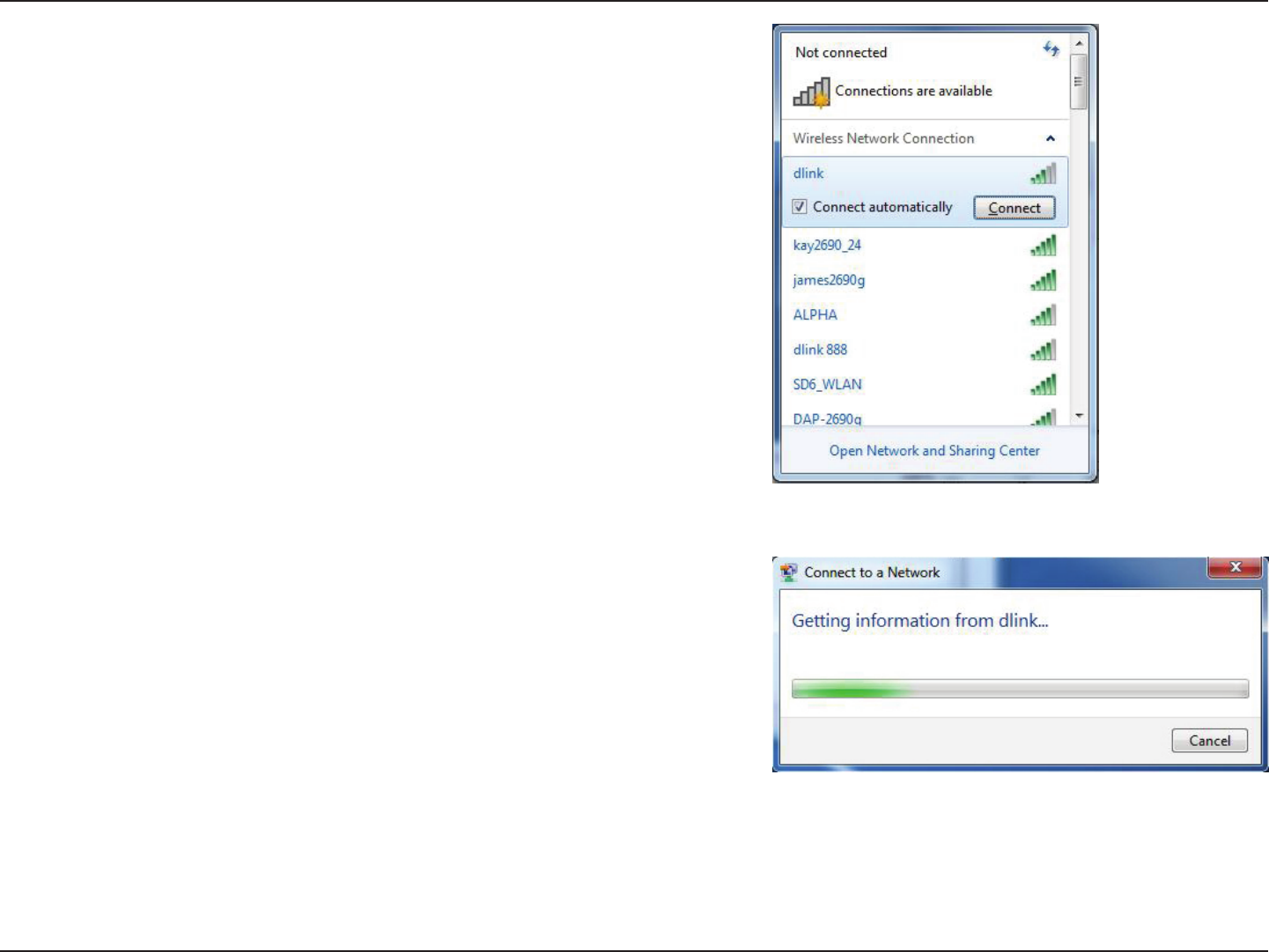
67D-Link DWR-961 User Manual
Section 5 - Connecting to a Wireless Network
3. Highlight the wireless connection with Wi-Fi name (SSID) you would
like to connect to and click the Connect button.
If you get a good signal but cannot access the Internet, check your
TCP/IP settings for your wireless adapter. Refer to Networking Basics
on page 88 for more information.
4. The following window appears while your computer tries to connect
to the router.
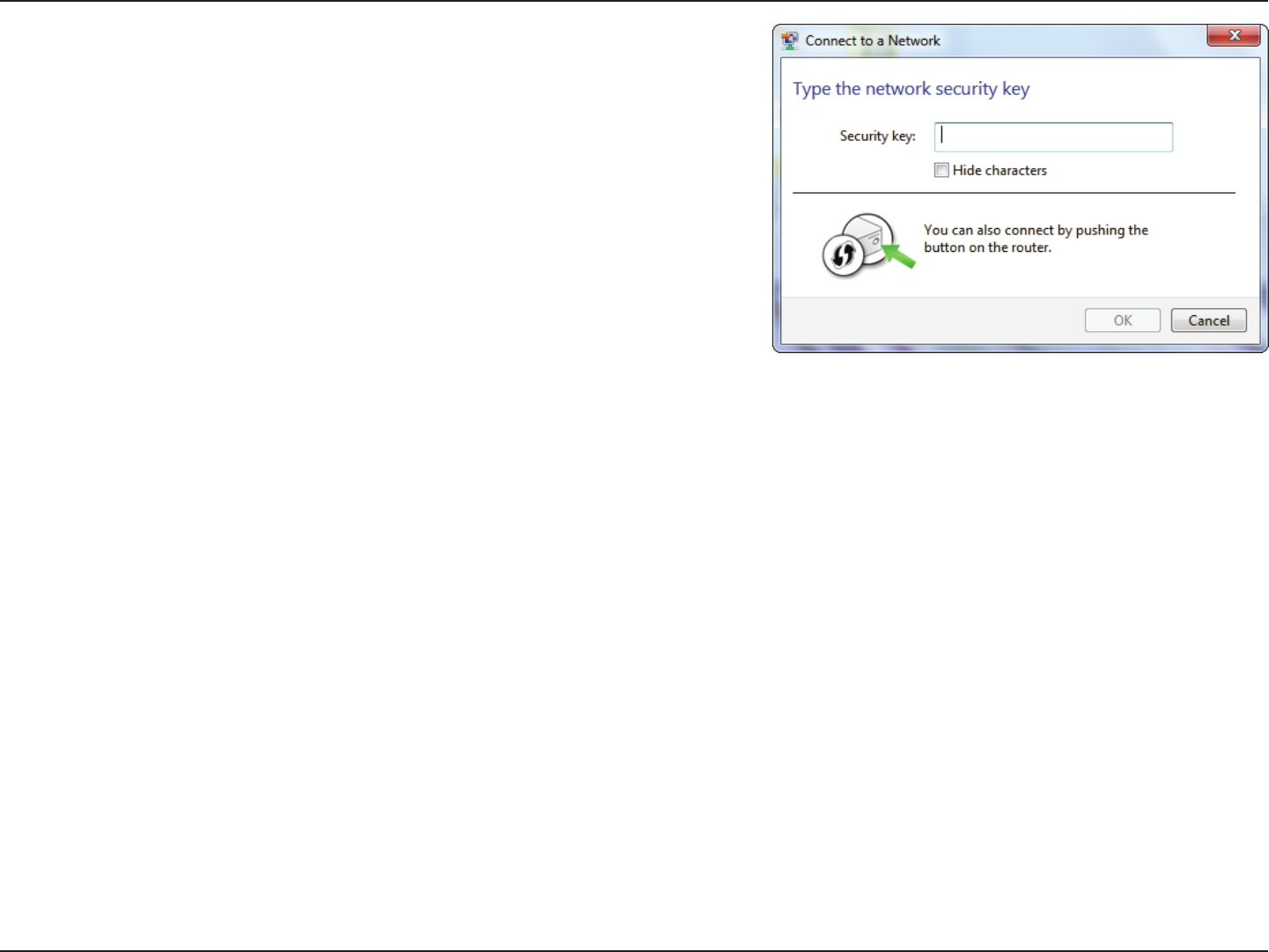
68D-Link DWR-961 User Manual
Section 5 - Connecting to a Wireless Network
5. Enter the same security key or passphrase (Wi-Fi password) that is on
your router and click Connect. You can also connect by pushing the
WPS button on the router.
It may take 20-30 seconds to connect to the wireless network. If the
connection fails, please verify that the security settings are correct. The
key or passphrase must be exactly the same as the one on the wireless
router.
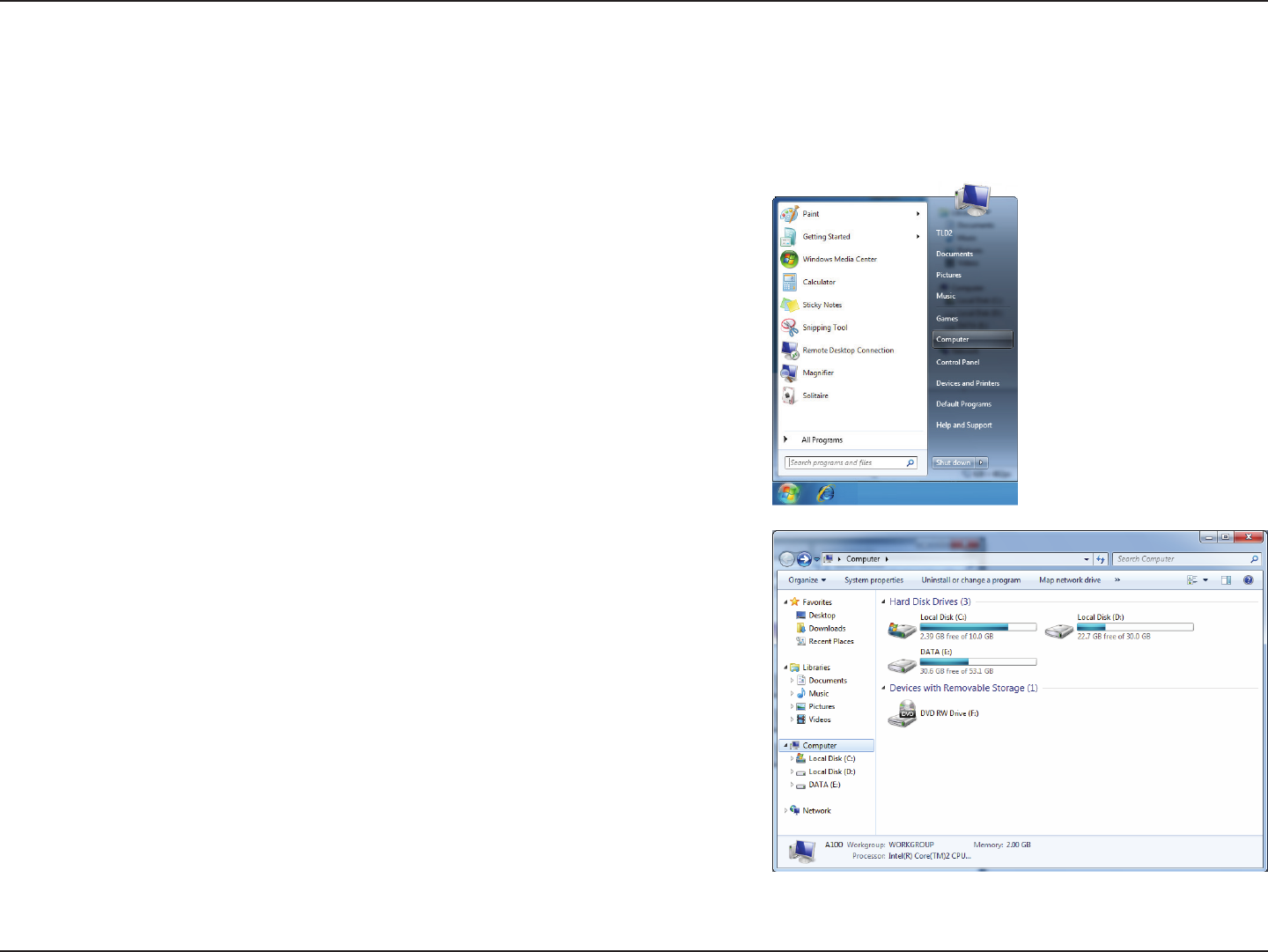
69D-Link DWR-961 User Manual
Section 5 - Connecting to a Wireless Network
WPS
The WPS feature of the DWR-961 can be congured using Windows® 7. Carry out the following steps to use Windows® 7 to
congure the WPS feature:
1. Click the Start button and select Computer from the Start menu.
2. Click Network on the left side.
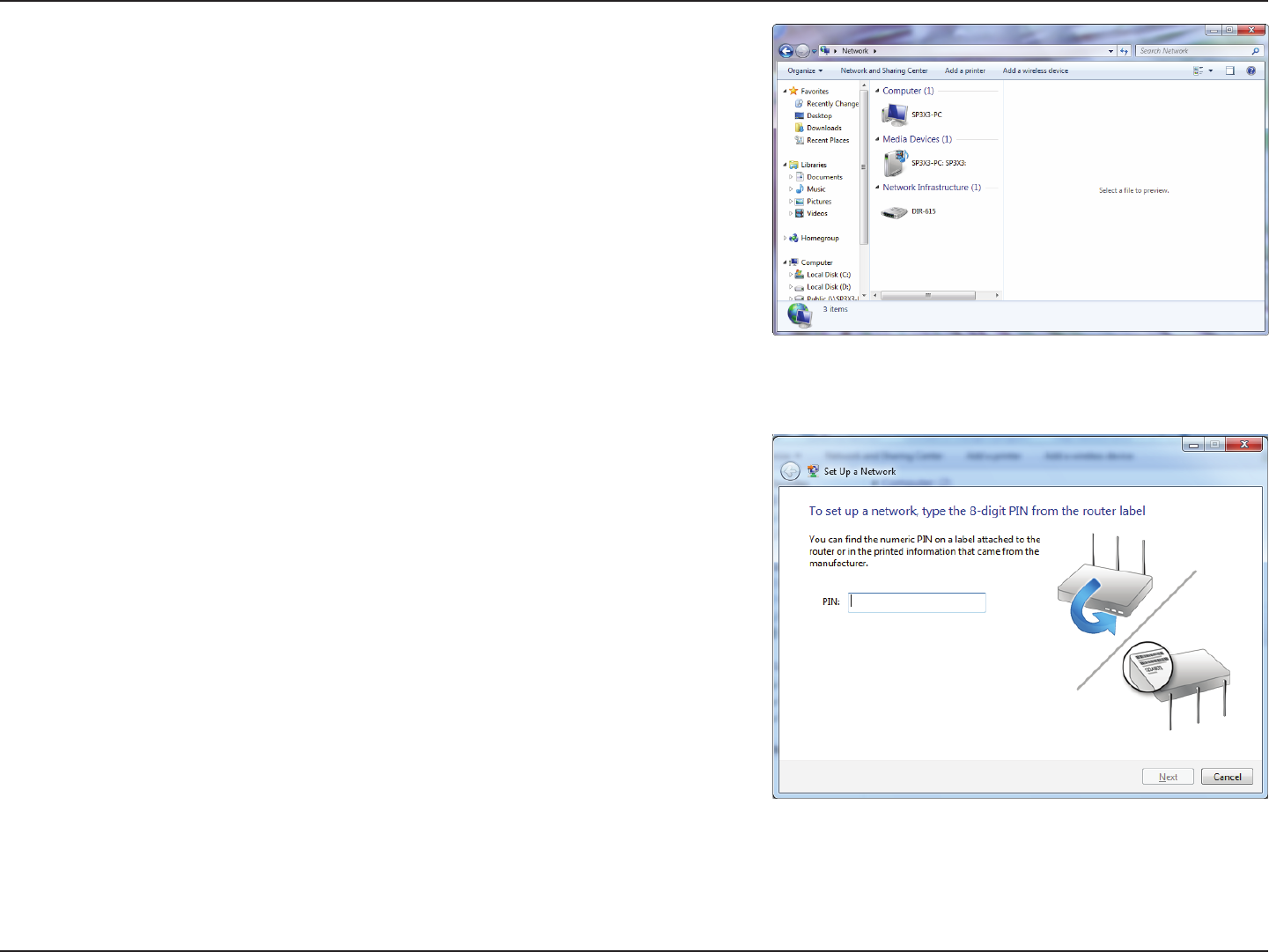
70D-Link DWR-961 User Manual
Section 5 - Connecting to a Wireless Network
3. Double-click the DWR-961.
4. Input the WPS PIN number (on the router label) in the Setup > Wireless
Setup menu in the Router’s Web UI) and click Next.
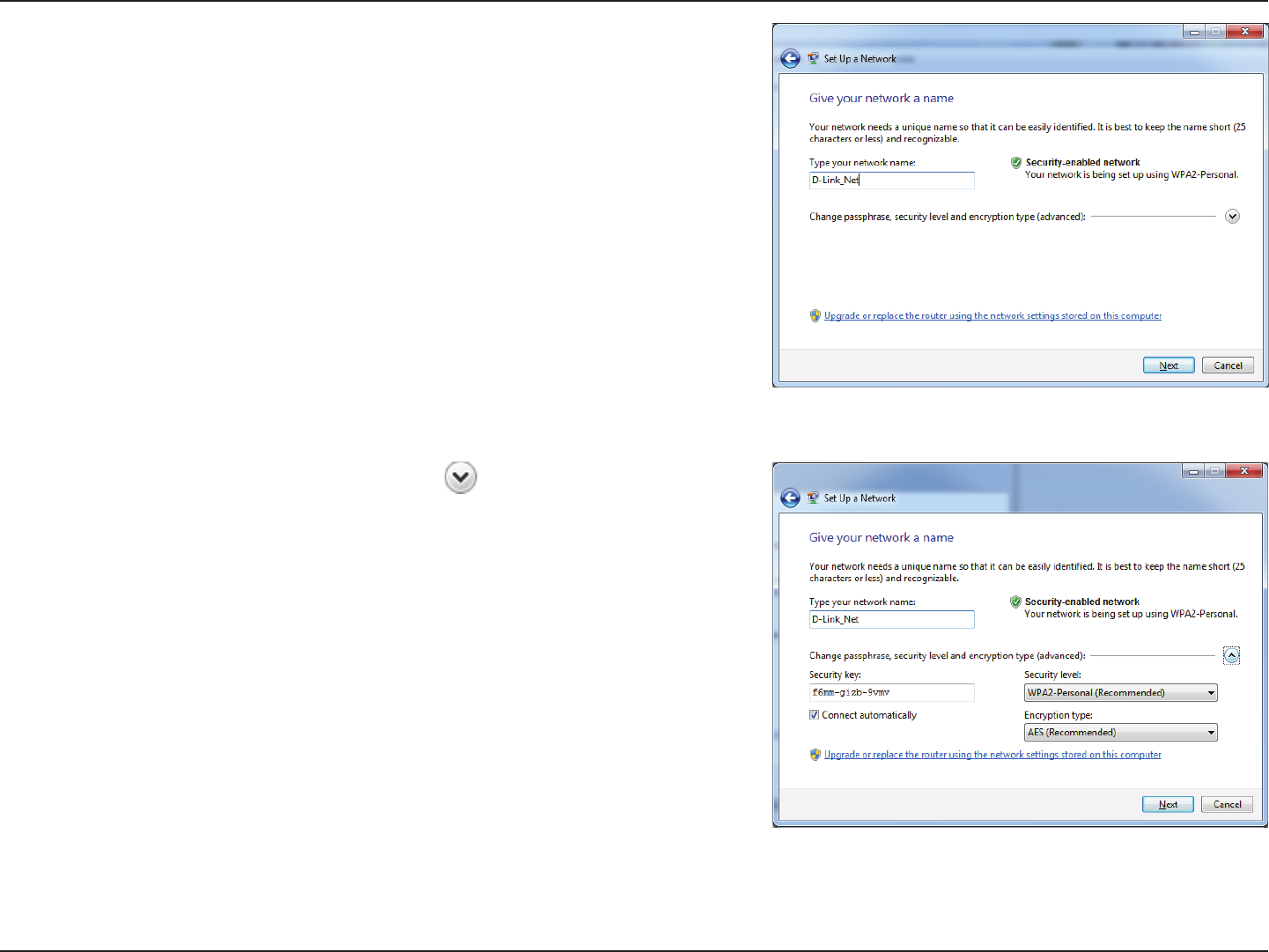
71D-Link DWR-961 User Manual
Section 5 - Connecting to a Wireless Network
5. Type a name to identify the network.
6. To congure advanced settings, click the icon.
Click Next to continue.
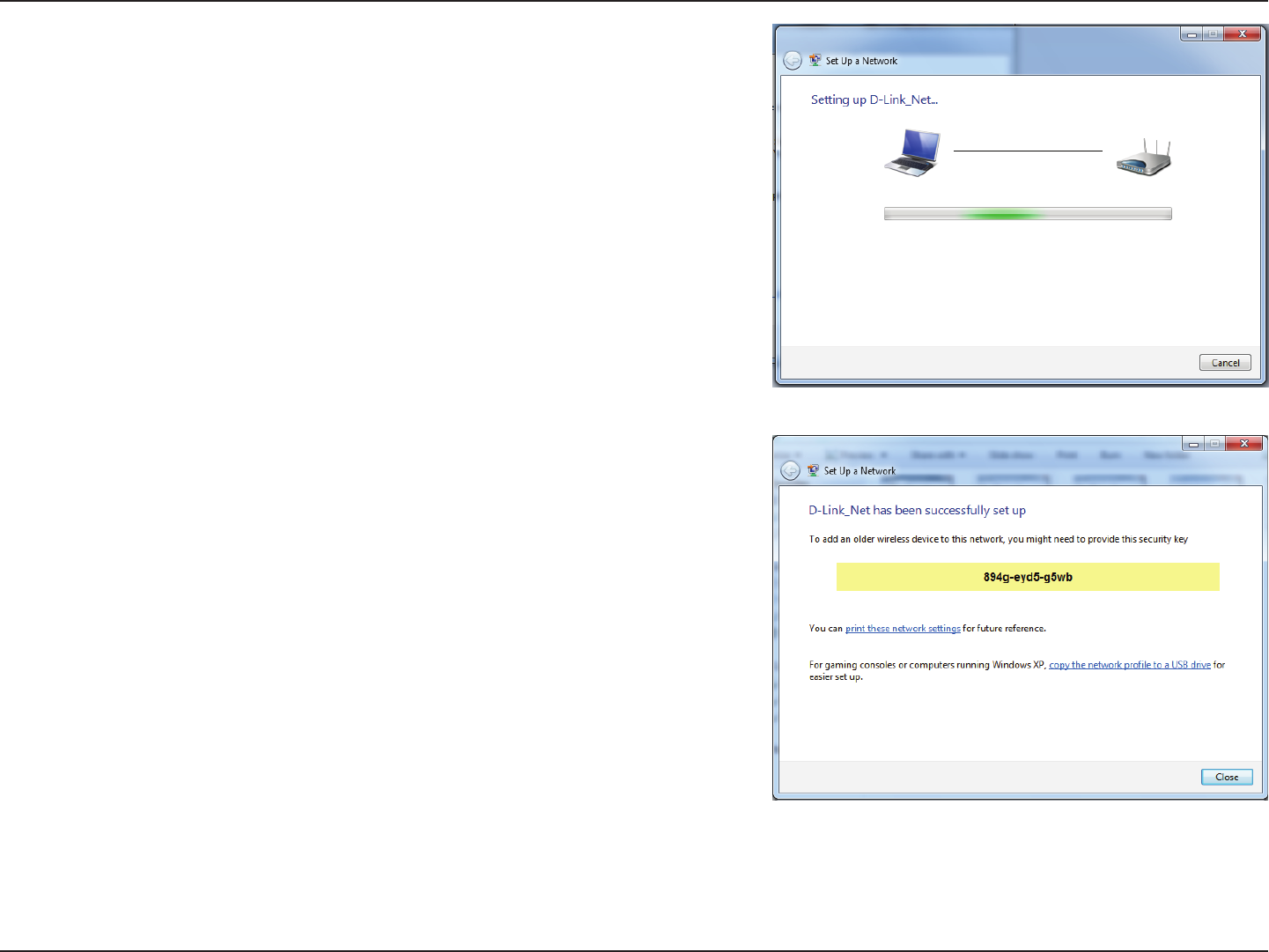
72D-Link DWR-961 User Manual
Section 5 - Connecting to a Wireless Network
7. The following window appears while the router is being congured.
Wait for the conguration to complete.
8. The following window informs you that WPS on the router has been
set up successfully.
Make a note of the security key as you may need to provide this security
key if adding an older wireless device to the network in the future.
9. Click Close to complete WPS setup.
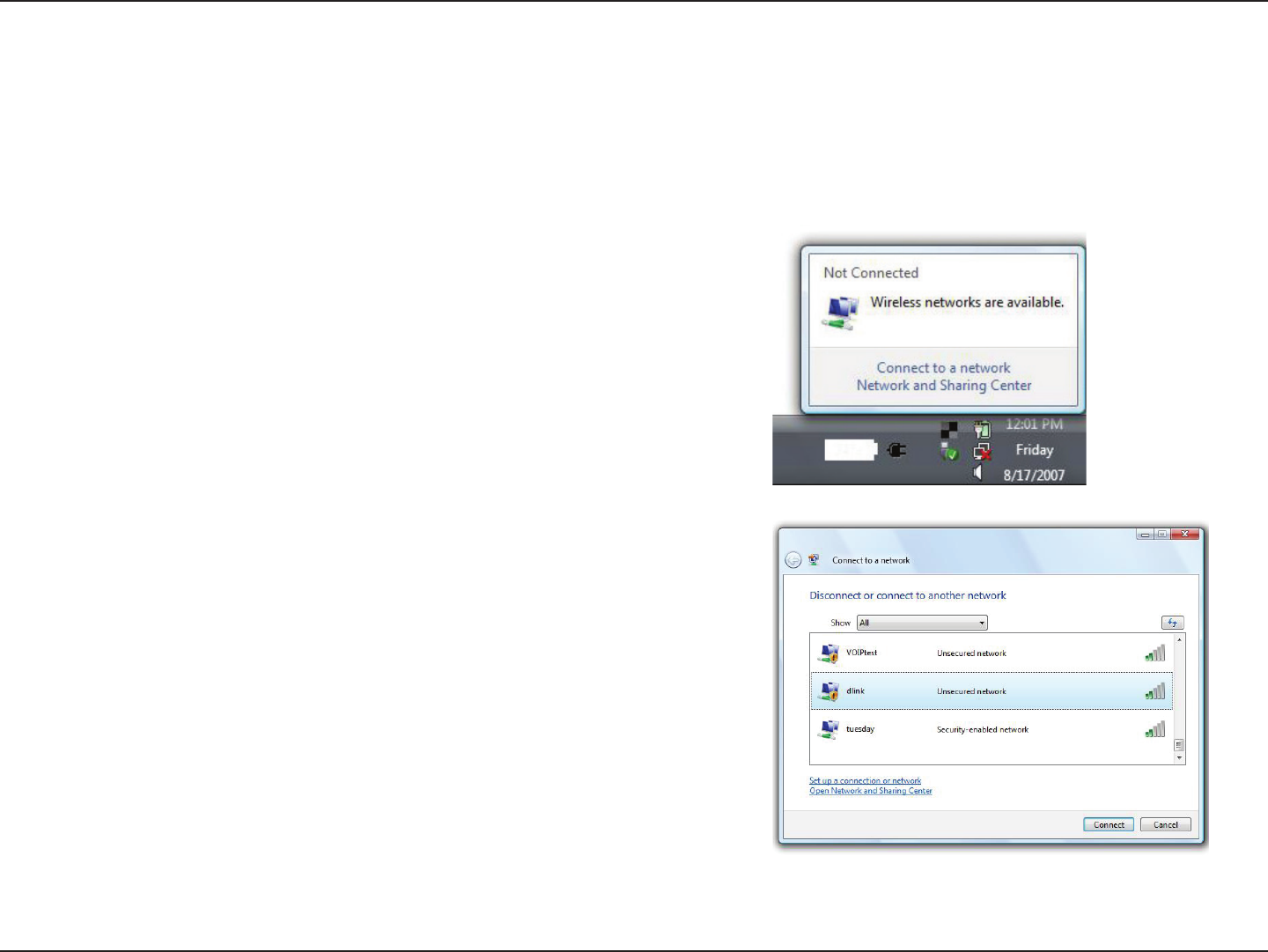
73D-Link DWR-961 User Manual
Section 5 - Connecting to a Wireless Network
Windows Vista®
Windows Vista® users may use the built-in wireless utility. If you are using another company’s wireless utility, please refer to the
user manual of your wireless adapter for help connecting to a wireless network. Most wireless utilities will have a “site survey”
option similar to the Windows Vista® utility as seen below.
Right-click on the wireless computer icon in your system tray (lower-right
corner next to the time). Select Connect to a network.
If you receive the Wireless Networks Detected bubble, click on the
center of the bubble to access the utility.
or
The utility will display any available wireless networks in your area. Click
on a network (displayed using the SSID) and click the Connect button.
If you get a good signal but cannot access the Internet, check you
TCP/IP settings for your wireless adapter. Refer to the Networking Basics
section in this manual for more information.
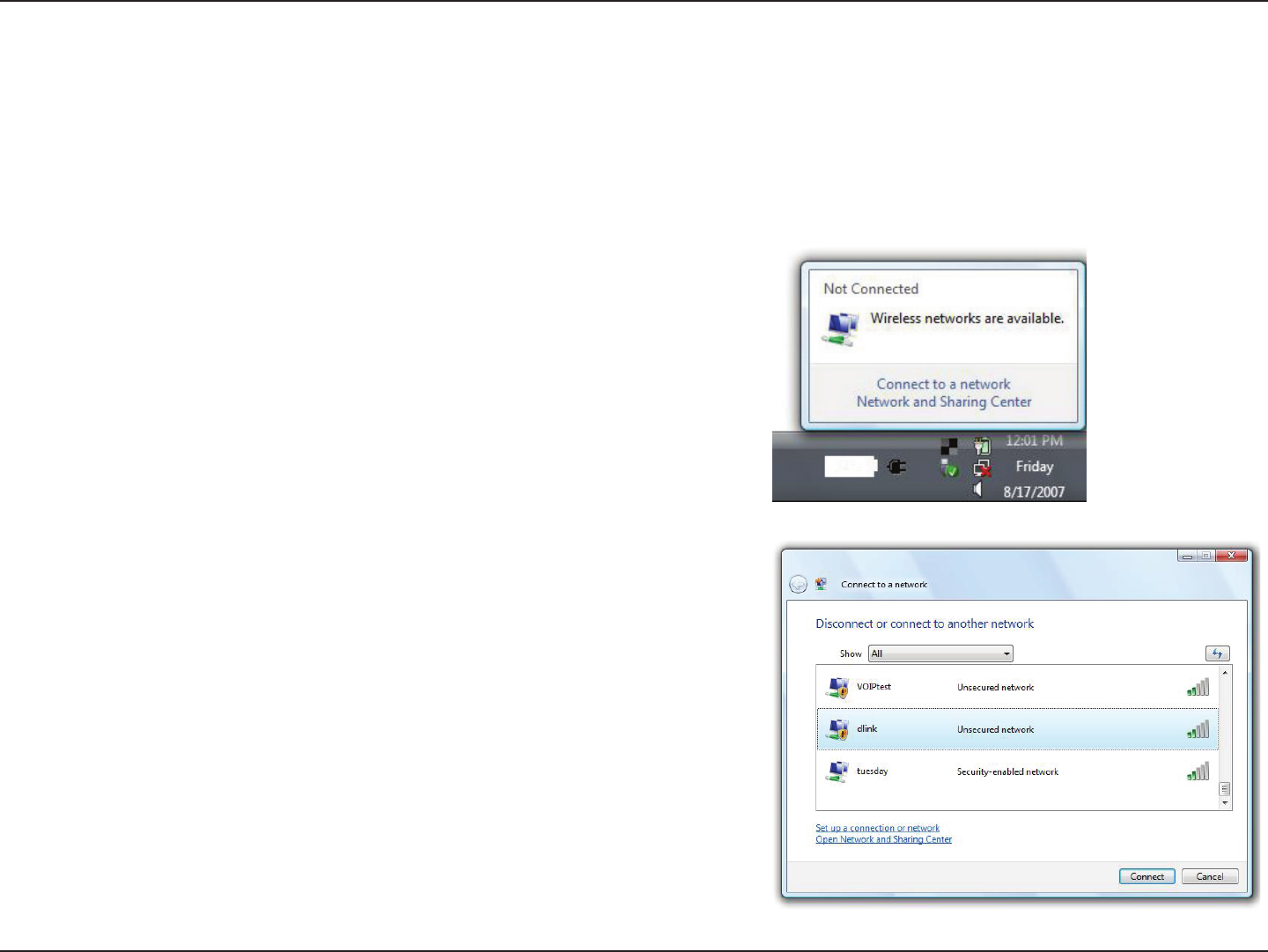
74D-Link DWR-961 User Manual
Section 5 - Connecting to a Wireless Network
WPA/WPA2
It is recommended that you enable wireless security (WPA/WPA2) on your wireless router or access point before conguring
your wireless adapter. If you are joining an existing network, you will need to know the security key or passphrase being used.
2. Highlight the Wi-Fi name (SSID) you would like to connect to and
click Connect.
1. Open the Windows Vista® Wireless Utility by right-clicking on the
wireless computer icon in your system tray (lower right corner of
screen). Select Connect to a network.
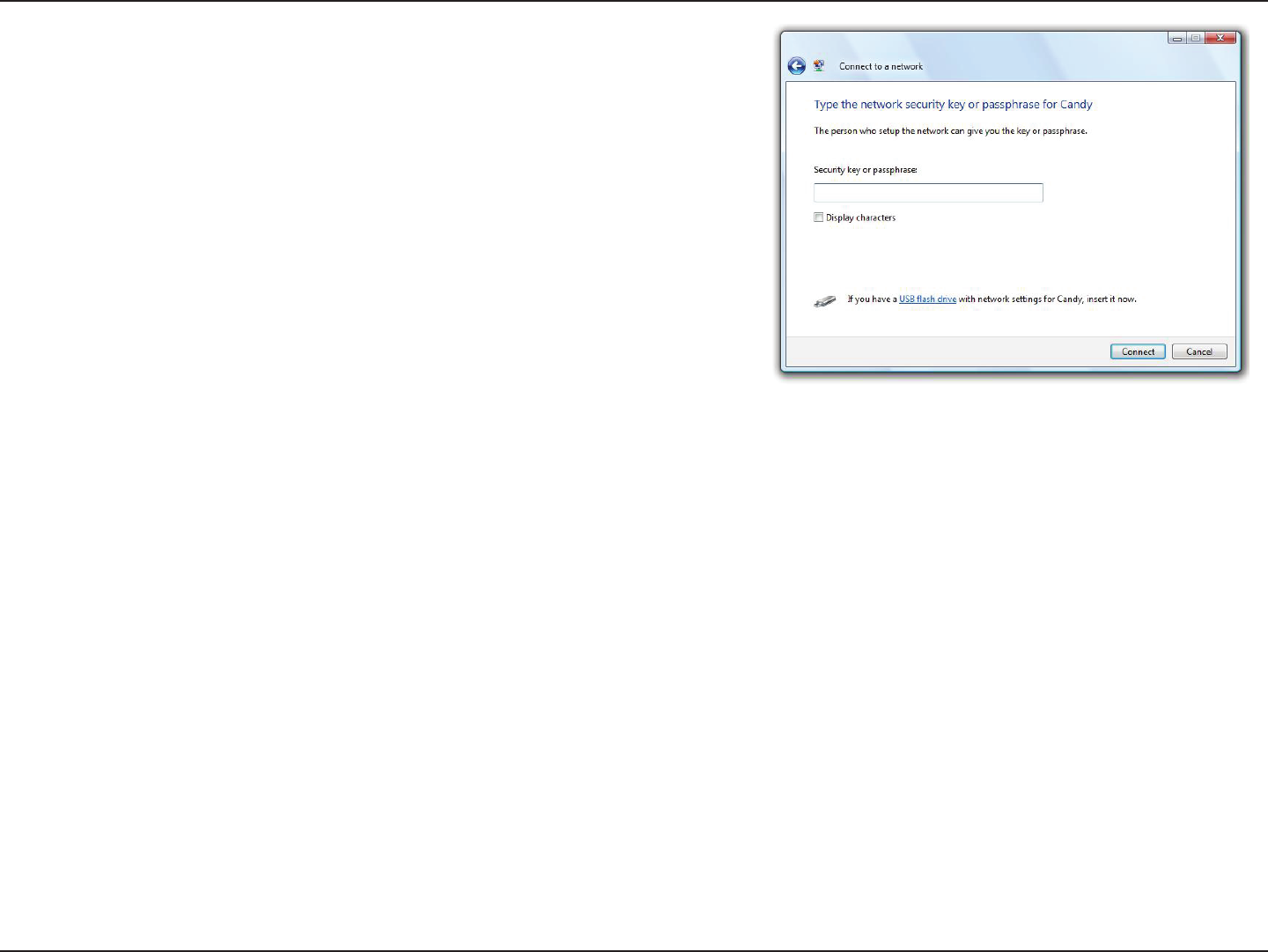
75D-Link DWR-961 User Manual
Section 5 - Connecting to a Wireless Network
3. Enter the same security key or passphrase (Wi-Fi password) that is on
your router and click Connect.
It may take 20-30 seconds to connect to the wireless network. If the
connection fails, please verify that the security settings are correct. The
key or passphrase must be exactly the same as the one on the wireless
router.
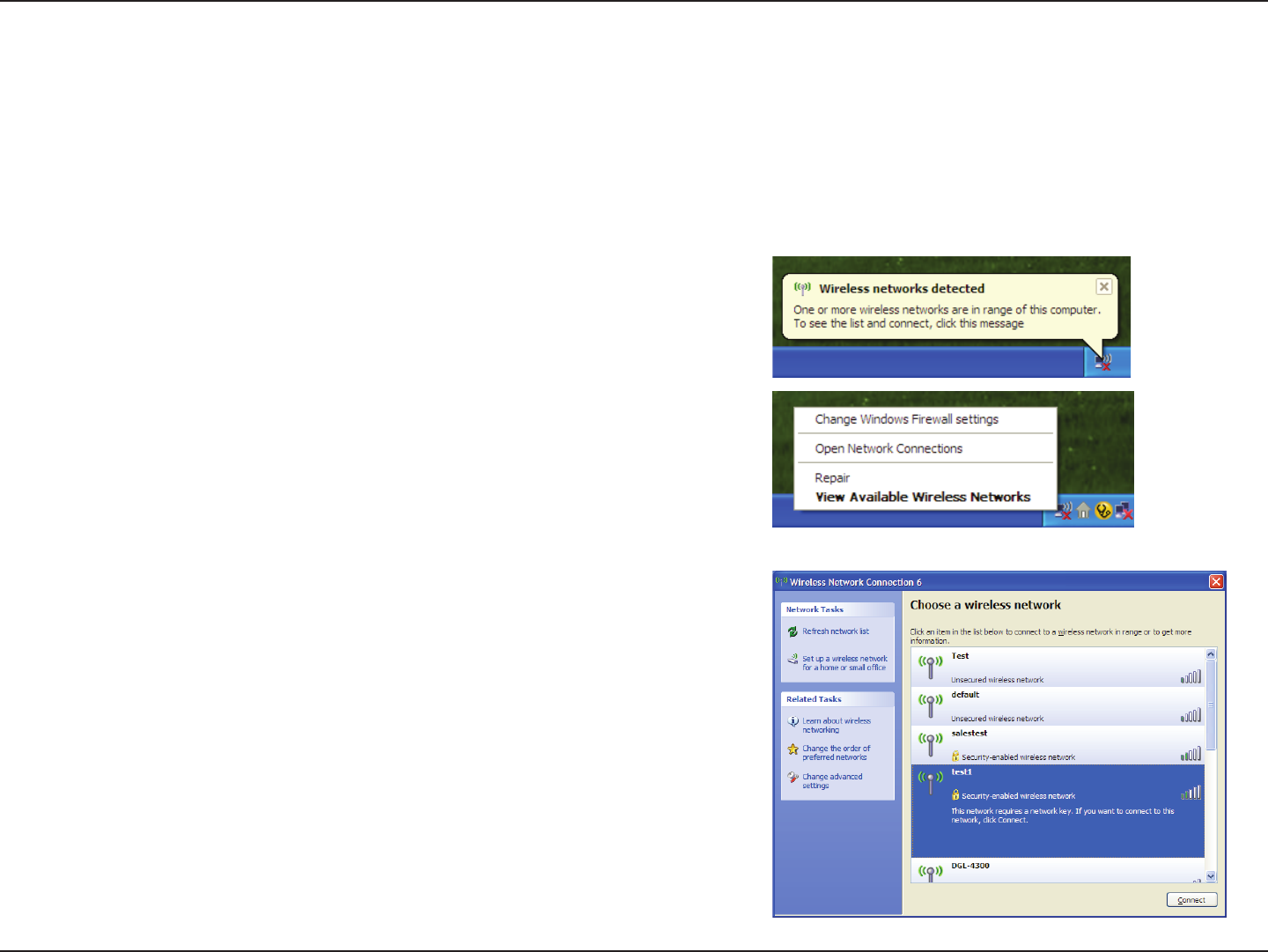
76D-Link DWR-961 User Manual
Section 5 - Connecting to a Wireless Network
Windows® XP
Windows® XP users may use the built-in wireless utility (Zero Conguration Utility). The following instructions are for Service
Pack 2 users. If you are using another company’s utility, please refer to the user manual of your wireless adapter for help with
connecting to a wireless network. Most utilities will have a “site survey” option similar to the Windows® XP utility as seen below.
Right-click on the wireless computer icon in your system tray (lower-right
corner next to the time). Select View Available Wireless Networks.
If you receive the Wireless Networks Detected bubble, click on the
center of the bubble to access the utility.
or
The utility will display any available wireless networks in your area. Click
on a Wi-Fi network (displayed using the SSID) and click the Connect
button.
If you get a good signal but cannot access the Internet, check you
TCP/IP settings for your wireless adapter. Refer to the Networking Basics
section in this manual for more information.
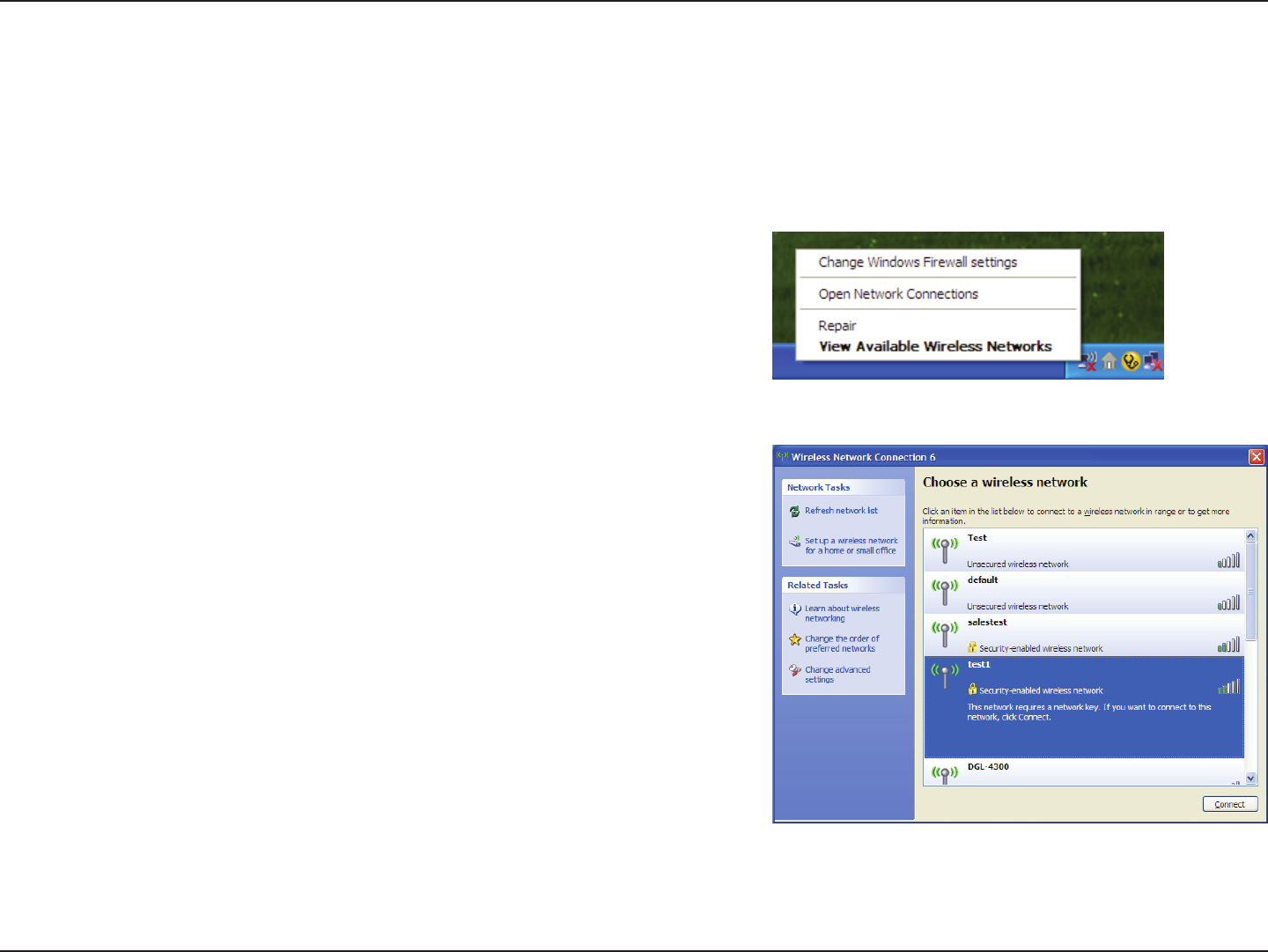
77D-Link DWR-961 User Manual
Section 5 - Connecting to a Wireless Network
It is recommended to enable WPA on your wireless router or access point before conguring your wireless adapter. If you are
joining an existing network, you will need to know the WPA key being used.
2. Highlight the Wi-Fi network (SSID) you would like to connect to and
click Connect.
1. Open the Windows® XP Wireless Utility by right-clicking on the wireless
computer icon in your system tray (lower-right corner of screen). Select
View Available Wireless Networks.
WPA/WPA2
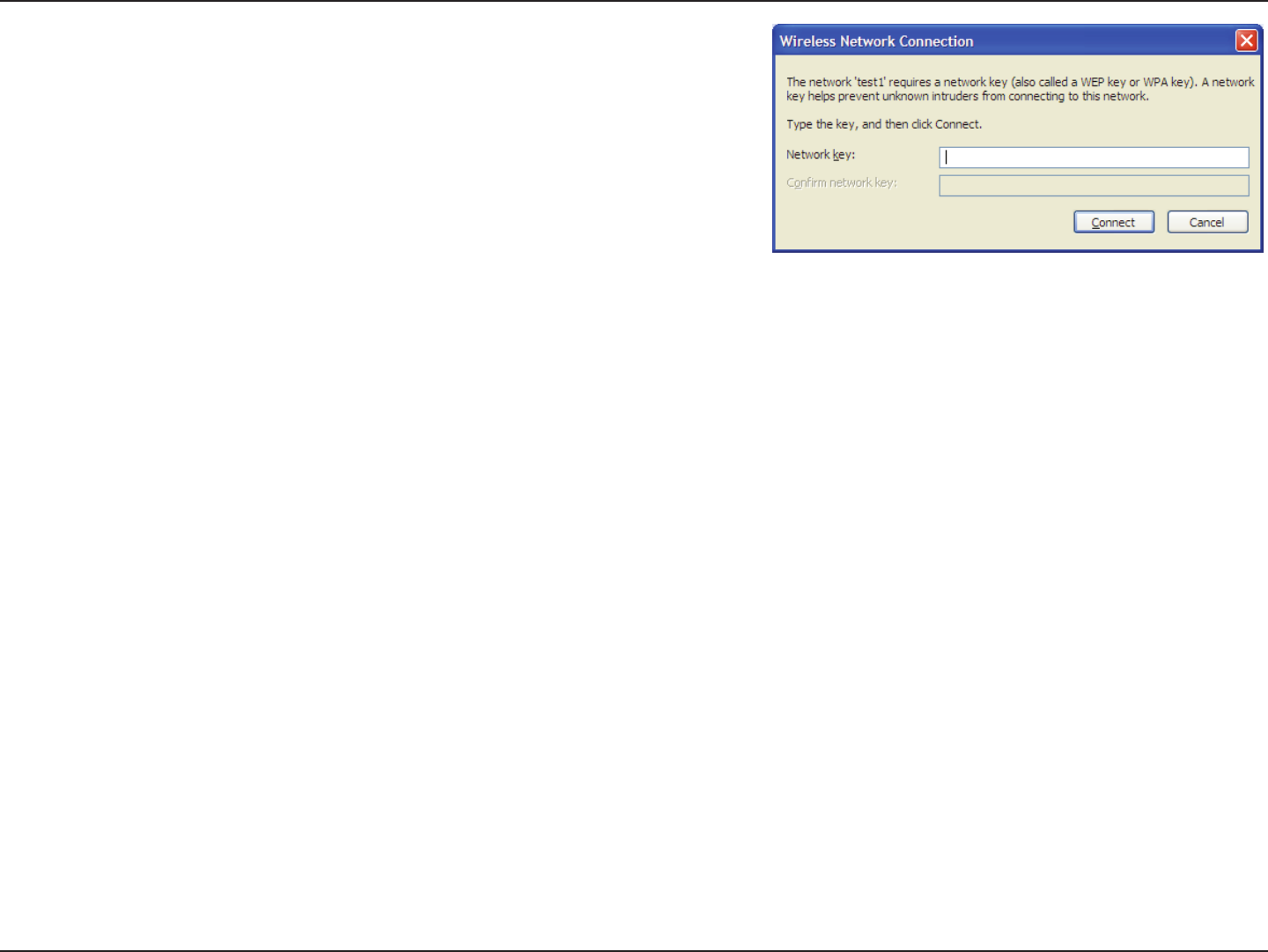
78D-Link DWR-961 User Manual
Section 5 - Connecting to a Wireless Network
3. The Wireless Network Connection box will appear. Enter the WPA-
PSK Wi-Fi password and click Connect.
It may take 20-30 seconds to connect to the wireless network. If the
connection fails, please verify that the WPA-PSK settings are correct. The
Wi-Fi password must be exactly the same as on the wireless router.

79D-Link DWR-961 User Manual
Section 6 - Troubleshooting
Troubleshooting
This chapter provides solutions to problems that can occur during the installation and operation of the DWR-961. Read the
following descriptions if you are having problems. The examples below are illustrated in Windows® XP. If you have a dierent
operating system, the screenshots on your computer will look similar to these examples.
1. Why can’t I access the web-based conguration utility?
When entering the IP address of the D-Link router (192.168.0.1 for example), you are not connecting to a website, nor do you
have to be connected to the Internet. The device has the utility built-in to a ROM chip in the device itself. Your computer must
be on the same IP subnet to connect to the web-based utility.
• Make sure you have an updated Java-enabled web browser. We recommend the following:
- Microsoft Internet Explorer® 7 or higher
- Mozilla Firefox 3.5 or higher
- Google™ Chrome 8 or higher
- Apple Safari 4 or higher
• Verify physical connectivity by checking for solid link lights on the device. If you do not get a solid link light, try using a
dierent cable, or connect to a dierent port on the device if possible. If the computer is turned o, the link light may not
be on.
• Disable any Internet security software running on the computer. Software rewalls such as ZoneAlarm, BlackICE, Sygate,
Norton Personal Firewall, and Windows® XP rewall may block access to the conguration pages. Check the help les included
with your rewall software for more information on disabling or conguring it.

80D-Link DWR-961 User Manual
Section 6 - Troubleshooting
• Congure your Internet settings:
• Go to Start > Settings > Control Panel. Double-click the Internet Options Icon. From the Security tab, click
the button to restore the settings to their defaults.
• Click the Connection tab and set the dial-up option to Never Dial a Connection. Click the LAN Settings button.
Make sure nothing is checked. Click OK.
• Go to the Advanced tab and click the button to restore these settings to their defaults. Click OK three times.
• Close your web browser (if open) and open it.
• Access the web management. Open your web browser and enter the IP address of your D-Link router in the address bar. This
should open the login page for your web management.
• If you still cannot access the conguration, unplug the power to the router for 10 seconds and plug back in. Wait about 30
seconds and try accessing the conguration. If you have multiple computers, try connecting using a dierent computer.
2. What can I do if I forgot my password?
If you forgot your password, you must reset your router. This process will change all your settings back to the factory defaults.
To reset the router, locate the reset button (hole) on the rear panel of the unit. With the router powered on, use a paperclip
to hold the button down for 10 seconds. Release the button and the router will go through its reboot process. Wait about 30
seconds to access the router. The default IP address is 192.168.0.1. When logging in, leave the password box empty.
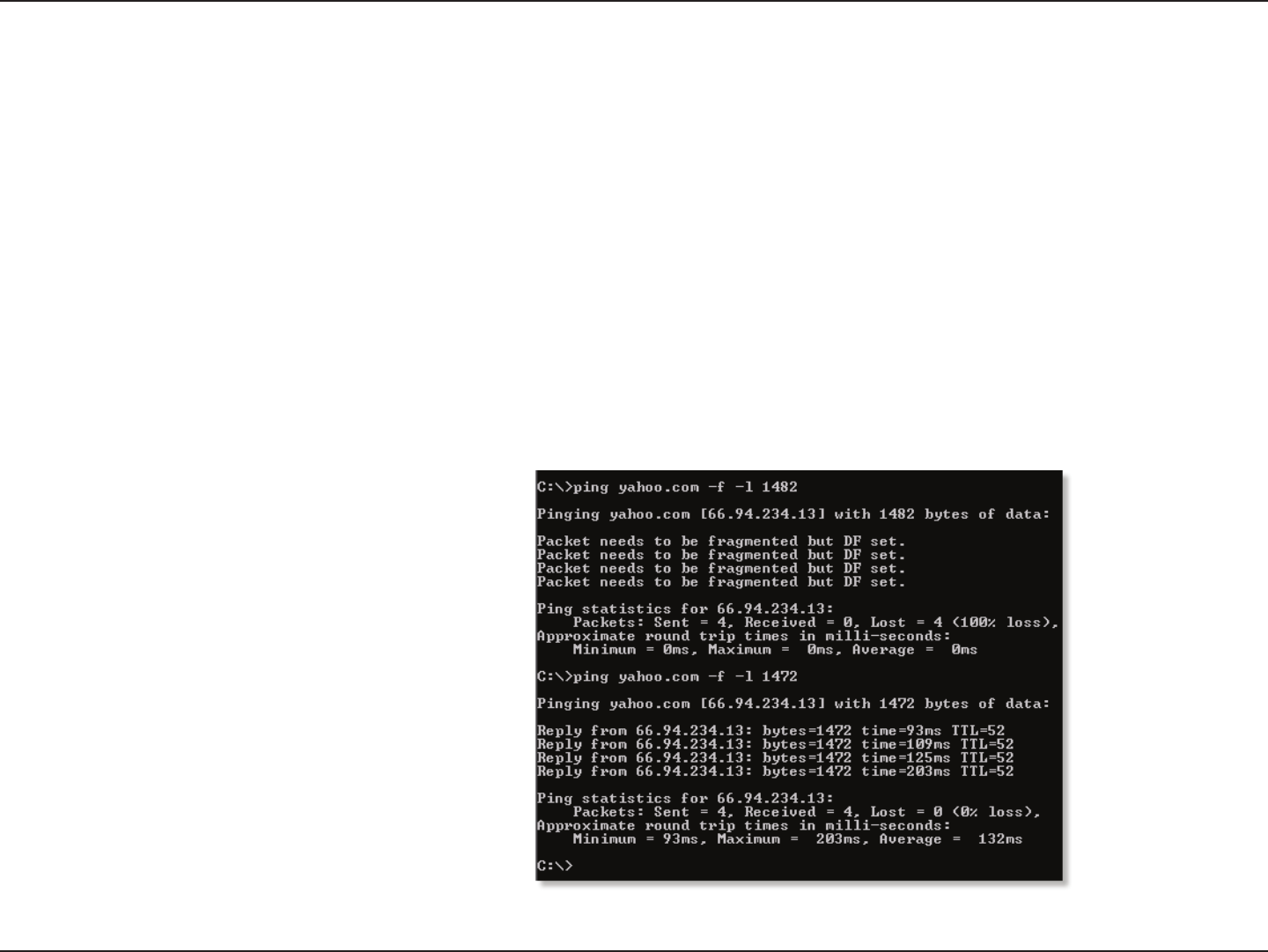
81D-Link DWR-961 User Manual
Section 6 - Troubleshooting
3. Why can’t I connect to certain sites or send and receive emails when connecting through my router?
If you are having a problem sending or receiving email, or connecting to secure sites such as eBay, banking sites, and Hotmail,
we suggest lowering the MTU in increments of ten (Ex. 1492, 1482, 1472, etc).
To nd the proper MTU Size, you’ll have to do a special ping of the destination you’re trying to go to. A destination could be
another computer, or a URL.
• Click on Start and then click Run.
• Windows® 95, 98, and Me users type in command (Windows® NT, 2000, XP, Vista®, and 7 users type in cmd) and
press Enter (or click OK).
• Once the window opens, you’ll need to do a special ping. Use the following syntax:
ping [url] [-f] [-l] [MTU value]
Example: ping yahoo.com -f -l 1472

82D-Link DWR-961 User Manual
Section 6 - Troubleshooting
You should start at 1472 and work your way down by 10 each time. Once you get a reply, go up by 2 until you get a fragmented
packet. Take that value and add 28 to the value to account for the various TCP/IP headers. For example, lets say that 1452 was the
proper value, the actual MTU size would be 1480, which is the optimum for the network we’re working with (1452+28=1480).
Once you nd your MTU, you can now congure your router with the proper MTU size.
To change the MTU rate on your router follow the steps below:
• Navigate to the Internet conguration page (see Internet on page 8 for details).
• To change the MTU, enter the number in the MTU eld and click Apply to save your settings.
• Test your email. If changing the MTU does not resolve the problem, continue changing the MTU in increments
of ten.

83D-Link DWR-961 User Manual
Appendix A - Wireless Basics
D-Link wireless products are based on industry standards to provide easy-to-use and compatible high-speed wireless
connectivity within your home, business, or public access wireless networks. Strictly adhering to the IEEE standard, the D-Link
wireless family of products will allow you to securely access the data you want, when, and where you want it. You will be able
to enjoy the freedom that wireless networking delivers.
A wireless local area network (WLAN) is a cellular computer network that transmits and receives data with radio signals instead
of wires. Wireless LANs are used increasingly in both home and oce environments, and public areas such as airports, coee
shops and universities. Innovative ways to utilize WLAN technology are helping people work, and communicate more eciently.
Increased mobility and the absence of cabling and other xed infrastructure have proven to be benecial for many users.
Wireless users can use the same applications they use on a wired network. Wireless adapter cards used on laptop and desktop
systems support the same protocols as Ethernet adapter cards.
Under many circumstances, it may be desirable for mobile network devices to link to a conventional Ethernet LAN in order to
use servers, printers or an Internet connection supplied through the wired LAN. A wireless router is a device used to provide
this link.
Wireless Basics

84D-Link DWR-961 User Manual
Appendix A - Wireless Basics
What is Wireless?
Wireless or Wi-Fi technology is another way of connecting your computer to the network without using wires. Wi-Fi uses radio
frequency to connect wirelessly so you have the freedom to connect computers anywhere in your home or oce network.
Why D-Link Wireless?
D-Link is the worldwide leader and award winning designer, developer, and manufacturer of networking products. D-Link
delivers the performance you need at a price you can aord. D-Link has all the products you need to build your network.
How does wireless work?
Wireless works similarly to how cordless phones work, through radio signals that transmit data from one point A to point B.
But wireless technology has restrictions as to how you can access the network. You must be within the wireless network range
area to be able to connect your computer. There are two dierent types of wireless networksl: Wireless Local Area Network
(WLAN), and Wireless Personal Area Network (WPAN).
Wireless Local Area Network (WLAN)
In a wireless local area network, a device called an Access Point (AP) connects computers to the network. The access point
has a small antenna attached to it, which allows it to transmit data back and forth over radio signals. With an indoor access
point the signal can travel up to 300 feet. With an outdoor access point the signal can reach out up to 30 miles to serve places
like manufacturing plants, industrial locations, university and high school campuses, airports, golf courses, and many other
outdoor venues.

85D-Link DWR-961User Manual
Appendix A - Wireless Basics
Wireless Personal Area Network (WPAN)
Bluetooth is the industry standard wireless technology used for WPAN. Bluetooth devices in WPAN operate in a range up to
30 feet away.
Compared to WLAN the speed and wireless operation range are both less than WLAN, but in return it doesn’t use nearly as
much power. This makes it ideal for personal devices, such as mobile phones, PDAs, headphones, laptops, speakers, and other
devices that operate on batteries.
Who uses wireless?
Wireless technology as become so popular in recent years that almost everyone is using it, whether it’s for home, oce, business,
D-Link has a wireless solution for it.
Home Uses/Benets
• Gives everyone at home broadband access
• Surf the web, check email, instant message, etc.
• Gets rid of the cables around the house
• Simple and easy to use
Small Oce and Home Oce Uses/Benets
• Stay on top of everything at home as you would at oce
• Remotely access your oce network from home
• Share Internet connection and printer with multiple computers
• No need to dedicate oce space

86D-Link DWR-961 User Manual
Appendix A - Wireless Basics
Where is wireless used?
Wireless technology is expanding everywhere, not just at home or oce. People like the freedom of mobility and it’s becoming
so popular that more and more public facilities now provide wireless access to attract people. The wireless connection in public
places is usually called “hotspots”.
Using a D-Link CardBus Adapter with your laptop, you can access the hotspot to connect to the Internet from remote locations
like: airports, hotels, coee shops, libraries restaurants, and convention centers.
Wireless network is easy to setup, but if you’re installing it for the rst time it could be quite a task not knowing where to start.
That’s why we’ve put together a few setup steps and tips to help you through the process of setting up a wireless network.
Tips
Here are a few things to keep in mind, when you install a wireless network.
Centralize your router or access point
Make sure you place the router/access point in a centralized location within your network for the best performance. Try to
place the router/access point as high as possible in the room, so the signal gets dispersed throughout your home. If you have
a two-story home, you may need a repeater to boost the signal to extend the range.
Eliminate interference
Place home appliances such as cordless telephones, microwaves, and televisions as far away as possible from the router/access
point. This would signicantly reduce any interference that the appliances might cause since they operate on same frequency.

87D-Link DWR-961 User Manual
Appendix A - Wireless Basics
Security
Don’t let your next-door neighbors or intruders connect to your wireless network. Secure your wireless network by turning on
the WPA or WEP security feature on the router. Refer to the product manual for detail information on how to set it up.
There are basically two modes of networking:
• Infrastructure – All wireless clients will connect to an access point or wireless router.
• Ad hoc – Directly connecting to another computer for peer-to-peer communication using wireless network
adapters on each computer, such as two or more DWR-961 wireless network CardBus adapters.
An Infrastructure network contains an access point or wireless router. All the wireless devices, or clients, will connect to the
wireless router or access point.
An ad hoc network contains only clients, such as laptops with wireless CardBus adapters. All the adapters must be in ad hoc
mode to communicate.
Wireless Modes
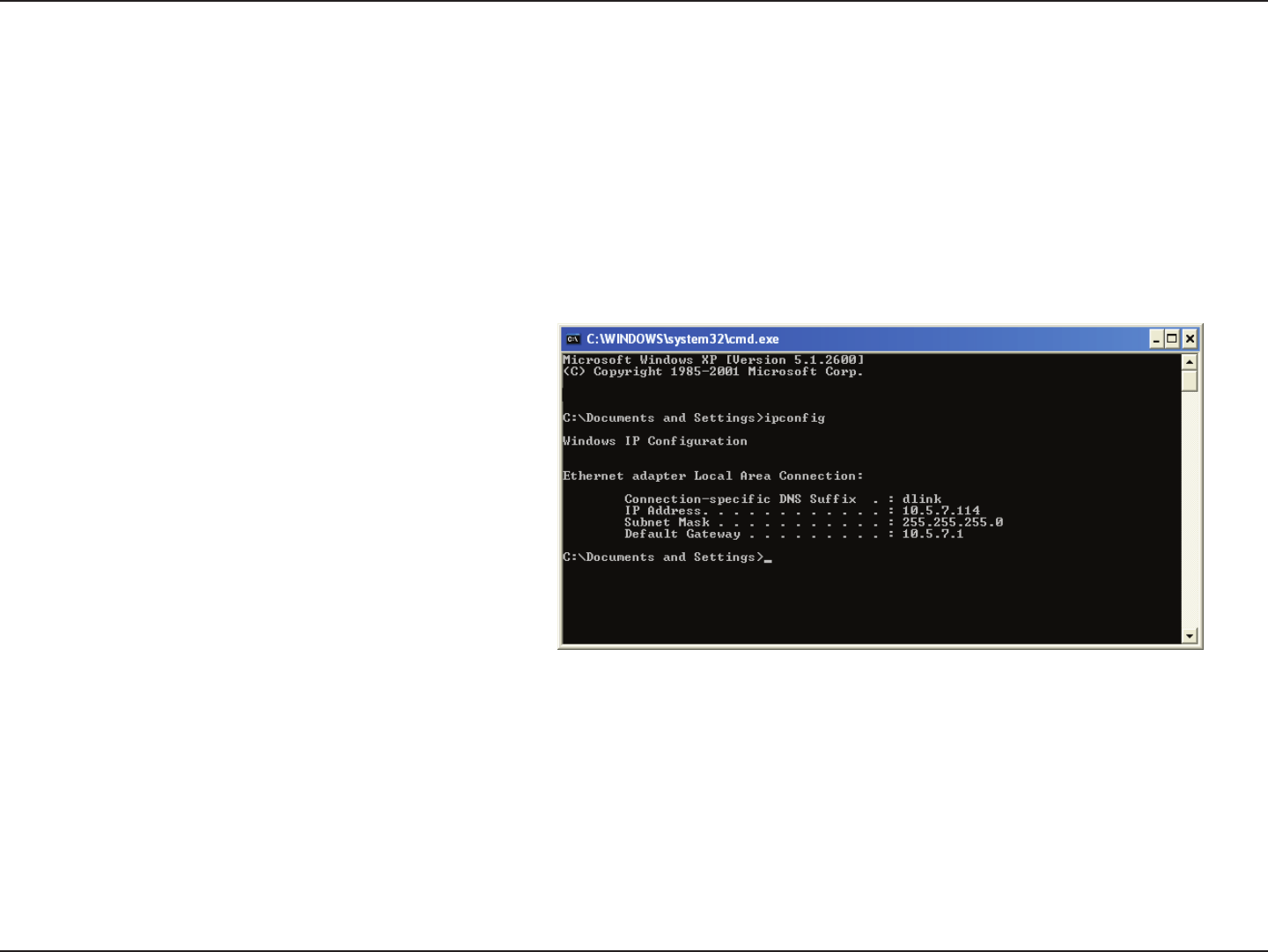
88D-Link DWR-961 User Manual
Appendix B - Networking Basics
Networking Basics
Check your IP address
After you install your new D-Link adapter, by default, the TCP/IP settings should be set to obtain an IP address from a DHCP
server (i.e. wireless router) automatically. To verify your IP address, please follow the steps below.
Click on Start > Run. In the run box type cmd and click OK. (Windows® 7/Vista® users type cmd in the Start Search box.)
At the prompt, type ipcong and press Enter.
This will display the IP address, subnet mask, and the
default gateway of your adapter.
If the address is 0.0.0.0, check your adapter installation,
security settings, and the settings on your router.
Some rewall software programs may block a DHCP
request on newly installed adapters.

89D-Link DWR-961 User Manual
Appendix B - Networking Basics
Statically Assign an IP address
If you are not using a DHCP capable gateway/router, or you need to assign a static IP address, please follow the steps below:
Step 1
Windows® 7 - Click on Start > Control Panel > Network and Internet > Network and Sharing Center.
Windows Vista® - Click on Start > Control Panel > Network and Internet > Network and Sharing Center > Manage Network
Connections.
Windows® XP - Click on Start > Control Panel > Network Connections.
Windows® 2000 - From the desktop, right-click My Network Places > Properties.
Step 2
Right-click on the Local Area Connection which represents your network adapter and select Properties.
Step 3
Highlight Internet Protocol Version 4 (TCP/IPv4) and click Properties.
Step 4
Click Use the following IP address and enter an IP address that is on the same subnet as
your network or the LAN IP address on your router.
Example: If the router´s LAN IP address is 192.168.0.1, make your IP address 192.168.1.X
where X is a number between 2 and 99. Make sure that the number you choose is not in
use on the network. Set the Default Gateway the same as the LAN IP address of your router
(I.E. 192.168.0.1).
Set Primary DNS the same as the LAN IP address of your router (192.168.0.1). The Alternate
DNS is not needed or you may enter a DNS server from your ISP.
Step 5
Click OK twice to save your settings.

90D-Link DWR-961 User Manual
Appendix B - Networking Basics
Wireless Security
This section will show you the dierent levels of security you can use to protect your data from intruders. The DWR-961 oers the
following types of security:
• WPA2 (Wi-Fi Protected Access 2) • WPA2-PSK (Pre-Shared Key)
• WPA (Wi-Fi Protected Access) • WPA-PSK (Pre-Shared Key)
What is WPA?
WPA (Wi-Fi Protected Access), is a Wi-Fi standard that was designed to improve the security features of WEP (Wired Equivalent Privacy).
The 2 major improvements over WEP:
• Improved data encryption through the Temporal Key Integrity Protocol (TKIP). TKIP scrambles the keys using a hashing
algorithm and by adding an integrity-checking feature, ensures that the keys haven’t been tampered with. WPA2 is based
on 802.11i and uses Advanced Encryption Standard (AES) instead of TKIP.
• User authentication, which is generally missing in WEP, through the extensible authentication protocol (EAP). WEP
regulates access to a wireless network based on a computer’s hardware-specic MAC address, which is relatively simple
to be snied out and stolen. EAP is built on a more secure public-key encryption system to ensure that only authorized
network users can access the network.
WPA-PSK/WPA2-PSK uses a passphrase or key to authenticate your wireless connection. The key is an alpha-numeric password between
8 and 63 characters long. The password can include symbols (!?*&_) and spaces. This key must be the exact same key entered on your
wireless router or access point.
WPA/WPA2 incorporates user authentication through the Extensible Authentication Protocol (EAP). EAP is built on a more secure public
key encryption system to ensure that only authorized network users can access the network.

91D-Link DWR-961 User Manual
Appendix C - Technical Specications
Technical Specications
LTE Band1
• Category 6: Band 2/4/5/12
Data Rates2
• Up to 866.7 Mbps with 802.11ac clients
• 6 / 9 / 11 / 12 / 18 / 24 / 36 / 48 / 54 Mbps in 802.11g mode
• 1 / 2 / 5.5 / 11 Mbps in 802.11b mode
• LTE Uplink: Up to 50 Mbps
• LTE Downlink: Up to 100 Mbps
Standards
• IEEE 802.11b/g, compatible with IEEE 802.11n/ac devices
• IEEE 802.3i
• IEEE 802.3u
Wireless Security
• 64 / 128-bit WEP (Wired Equivalent Privacy)
• WPA & WPA2 (Wi-Fi Protected Access)
Firewall
• Network Address Translation (NAT)
• Stateful Packet Inspection (SPI)
VPN
• L2TP/PPTP/IPSEC/VPN Pass-through
Antenna
• Two detachable 4G antennas
Ports
• Four LAN ports (RJ-45)
• WAN port (RJ-45)
SIM/UICC Slot
• Standard Mini-SIM/UICC slot
LED Status Indicators
• Power
• Internet
• 5GHz
• 2.4GHz
• 4G
• LAN/ WAN/ Signal Strength
Dimensions
• 170 x 180 x 80 mm
Operating Temperature
• 0 to 40 ˚C (32 to 104 ˚F)
Operating Humidity
• 10% to 90% (Non-condensing)
Certications
• FCC
• RoHS
1 Supported frequency band is dependent upon regional hardware version.
2 Maximum wireless signal rate derived from IEEE Standard 802.11g/b/n/ac specications. Actual data throughput will vary. Network conditions and environmental factors, including volume of network trac, building
materials and construction, and network overhead, lower actual data throughput rate. Environmental factors will adversely aect wireless signal range.

92D-Link DWR-961 User Manual
Appendix D - Regulatory Information
Regulatory Information
Federal Communication Commission Interference Statement
This equipment has been tested and found to comply with the limits for a Class B digital device, pursuant to Part 15 of the FCC Rules. These limits
are designed to provide reasonable protection against harmful interference in a residential installation. This equipment generates, uses and
can radiate radio frequency energy and, if not installed and used in accordance with the instructions, may cause harmful interference to radio
communications. However, there is no guarantee that interference will not occur in a particular installation. If this equipment does cause harmful
interference to radio or television reception, which can be determined by turning the equipment o and on, the user is encouraged to try to
correct the interference by one of the following measures:
- Reorient or relocate the receiving antenna.
- Increase the separation between the equipment and receiver.
- Connect the equipment into an outlet on a circuit dierent from that to which the receiver is connected.
- Consult the dealer or an experienced radio/TV technician for help.
Non-modications Statement:
Any changes or modications not expressly approved by the party responsible for compliance could void the user’s authority to operate this
equipment.
Caution:
This device complies with Part 15 of the FCC Rules. Operation is subject to the following two conditions:
(1) This device may not cause harmful interference, and (2) this device must accept any interference received, including interference that
may cause undesired operation.
For product available in the USA/Canada market, only channel 1~11 can be operated. Selection
of other channels is not possible.
Note
The country code selection is for non-USA models only and is not available to all USA models. Per FCC regulations, all WiFi product marketed in
the USA must be xed to USA operational channels only.

93D-Link DWR-961 User Manual
Appendix D - Regulatory Information
IMPORTANT NOTICE:
FCC Radiation Exposure Statement
This equipment complies with FCC radiation exposure limits set forth for an uncontrolled environment. This equipment should be installed and
operated with minimum distance 20 cm between the radiator and your body.